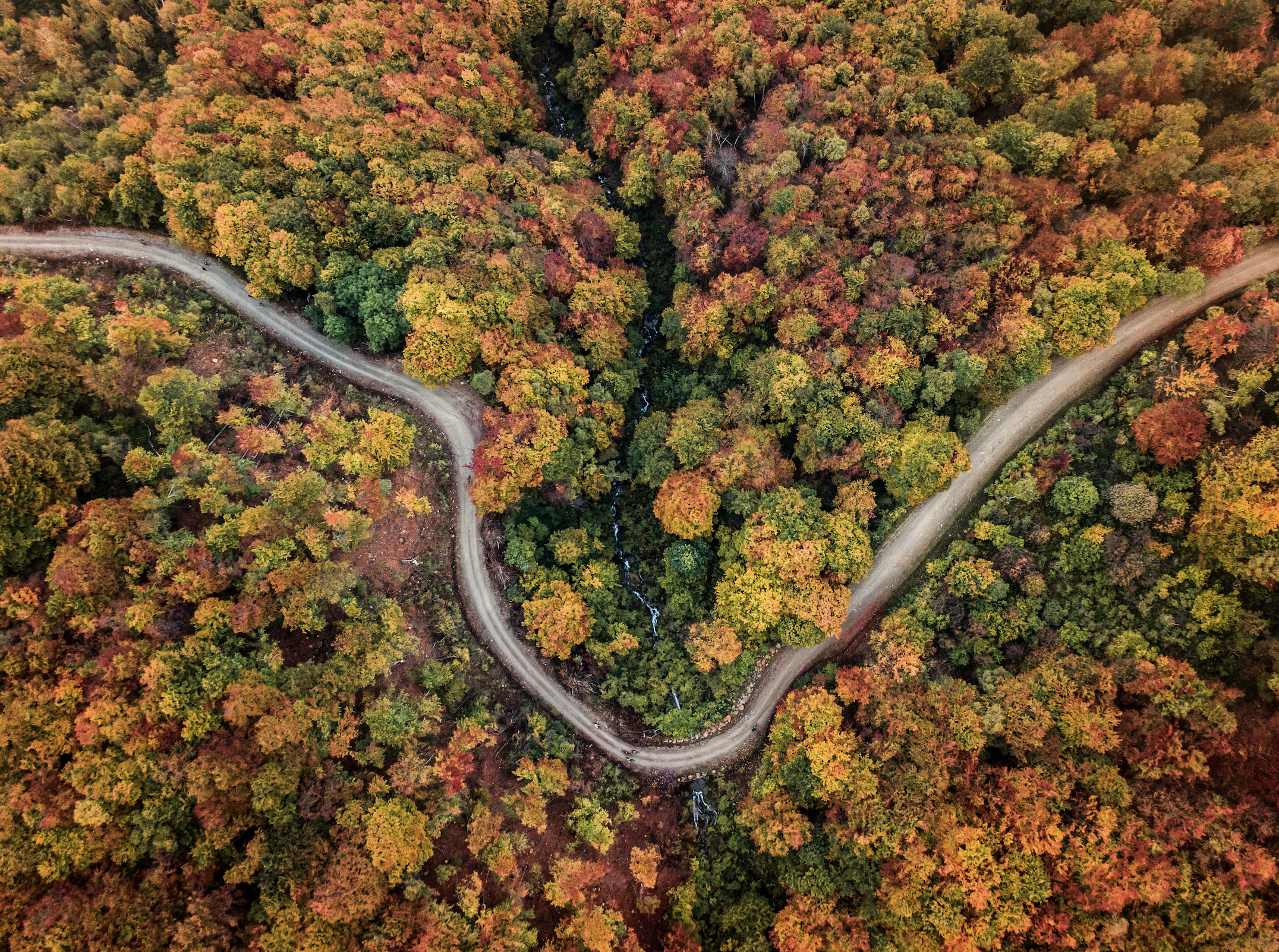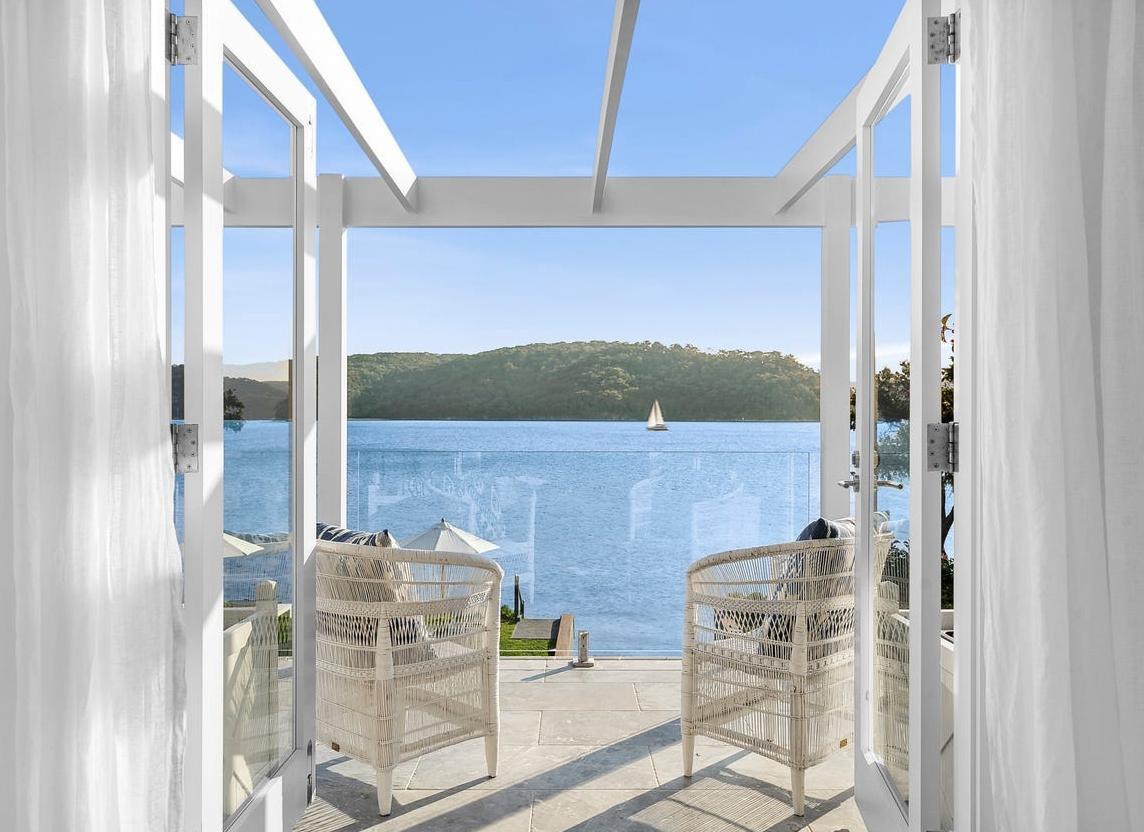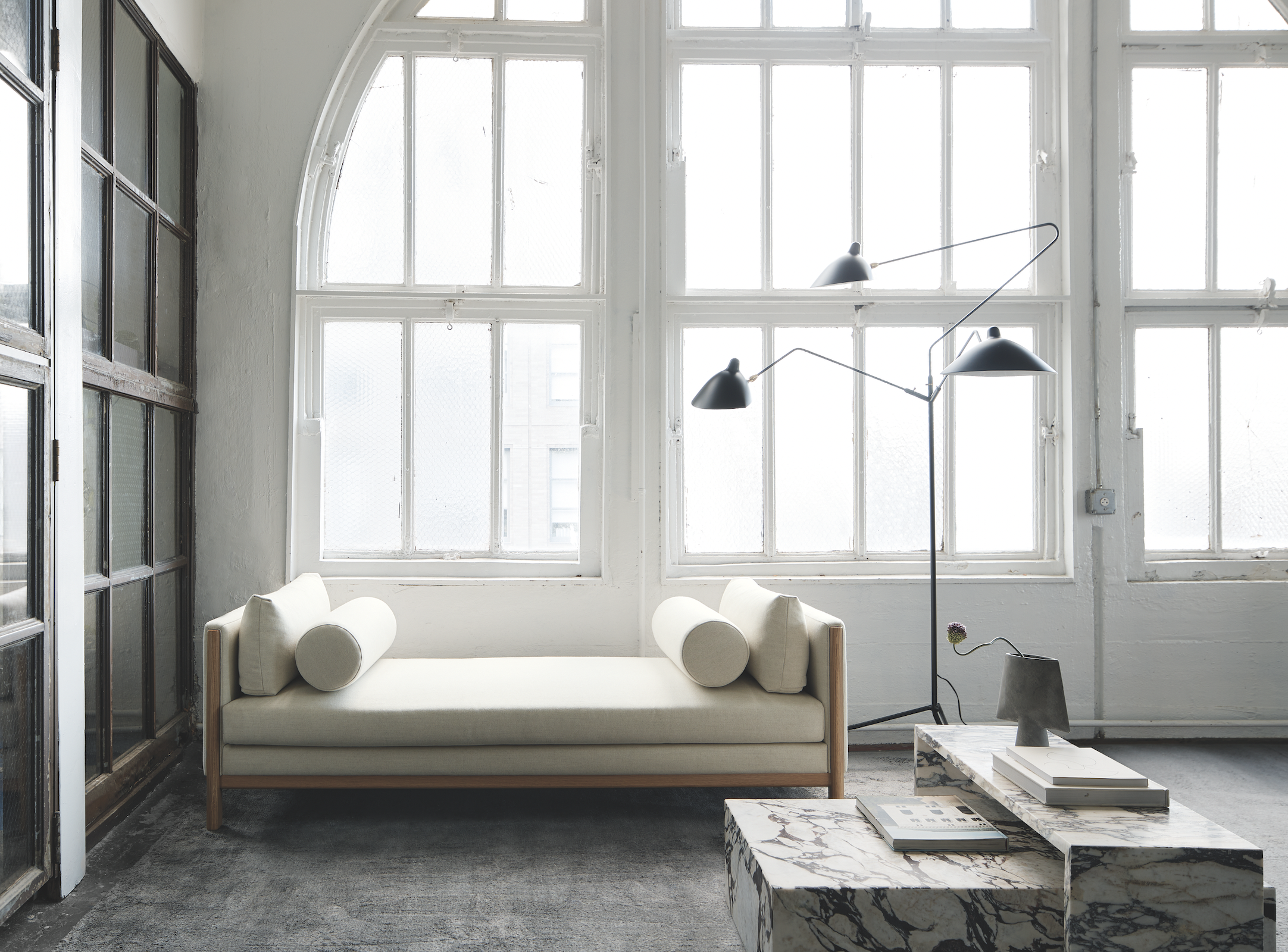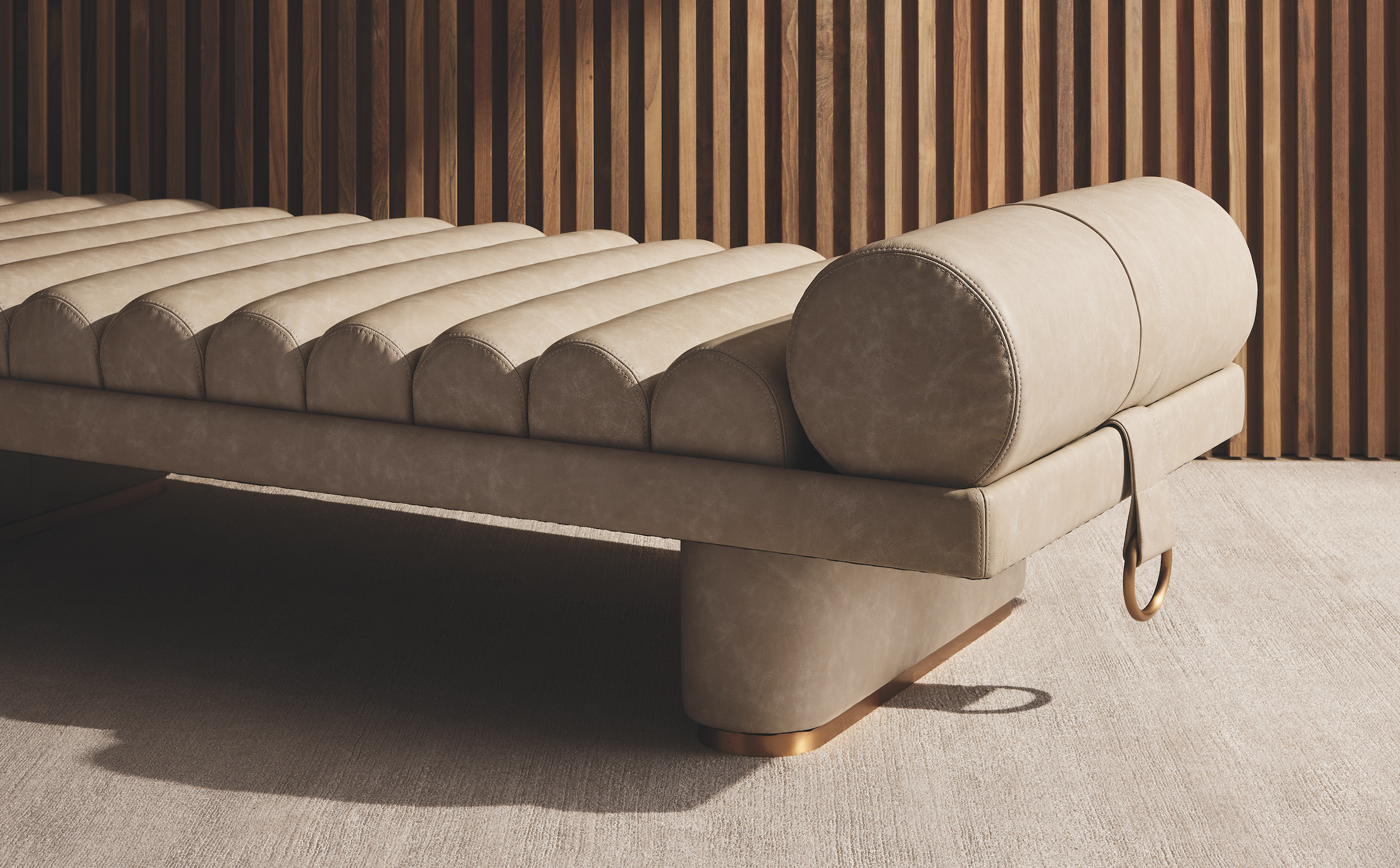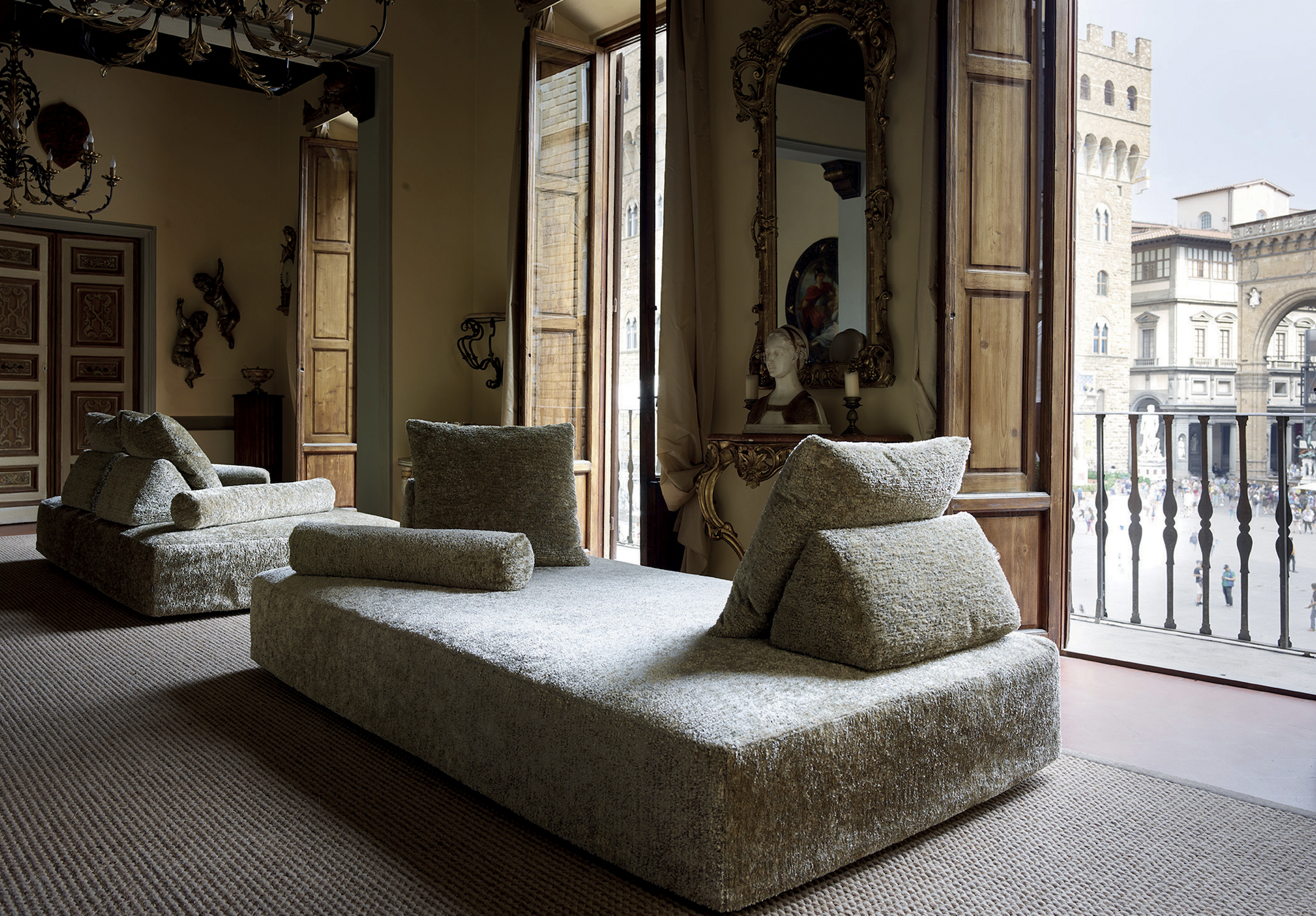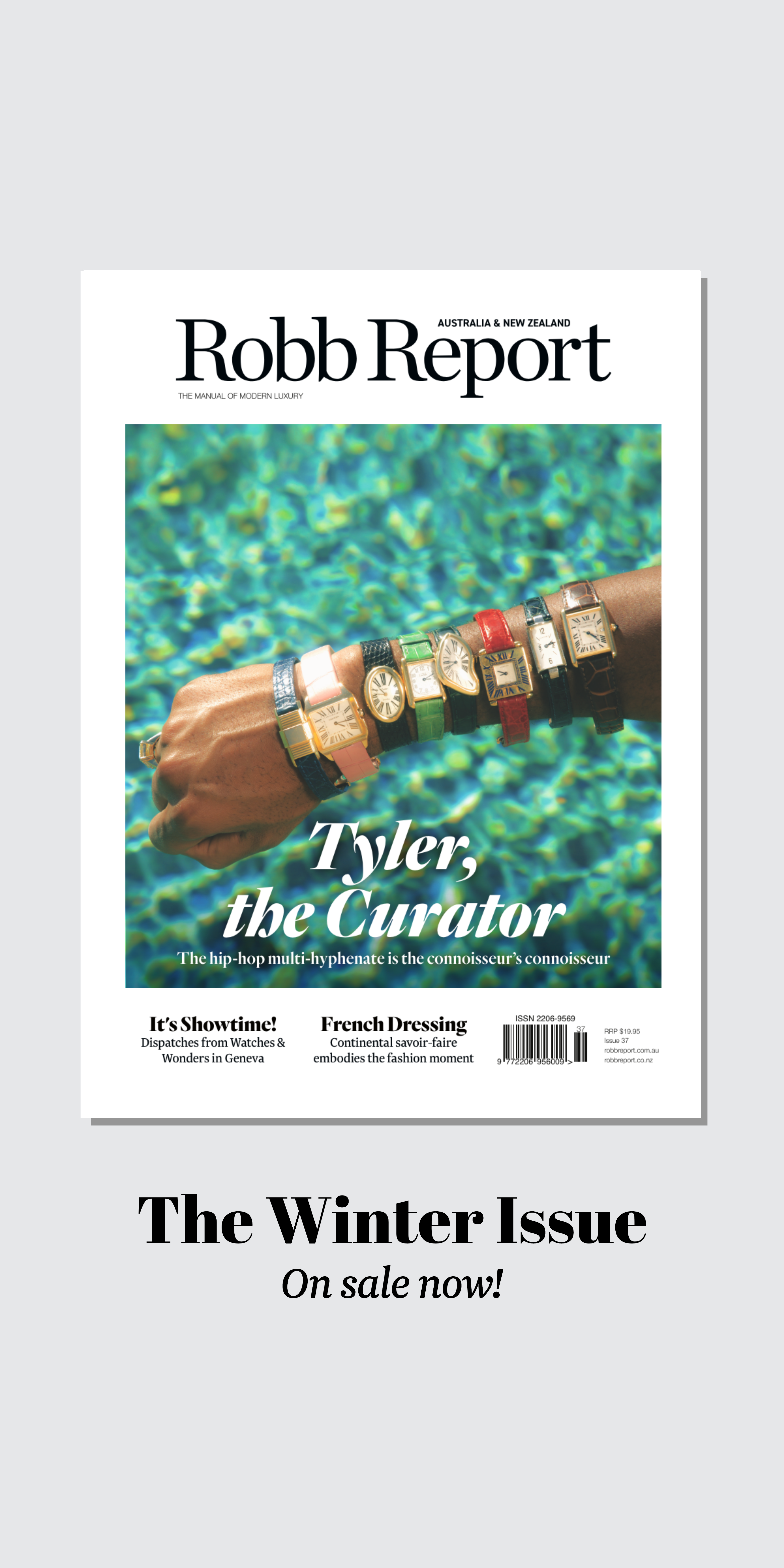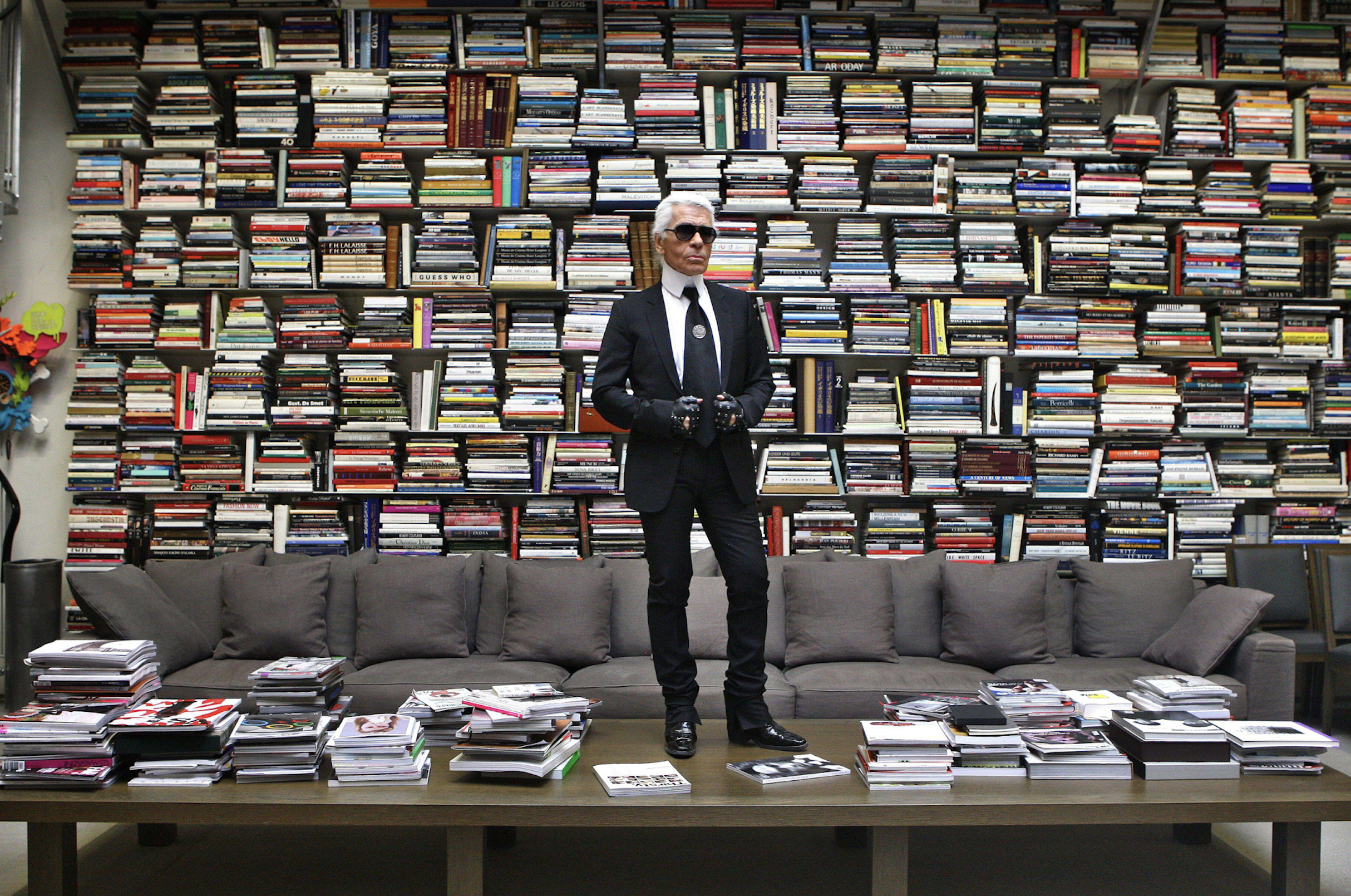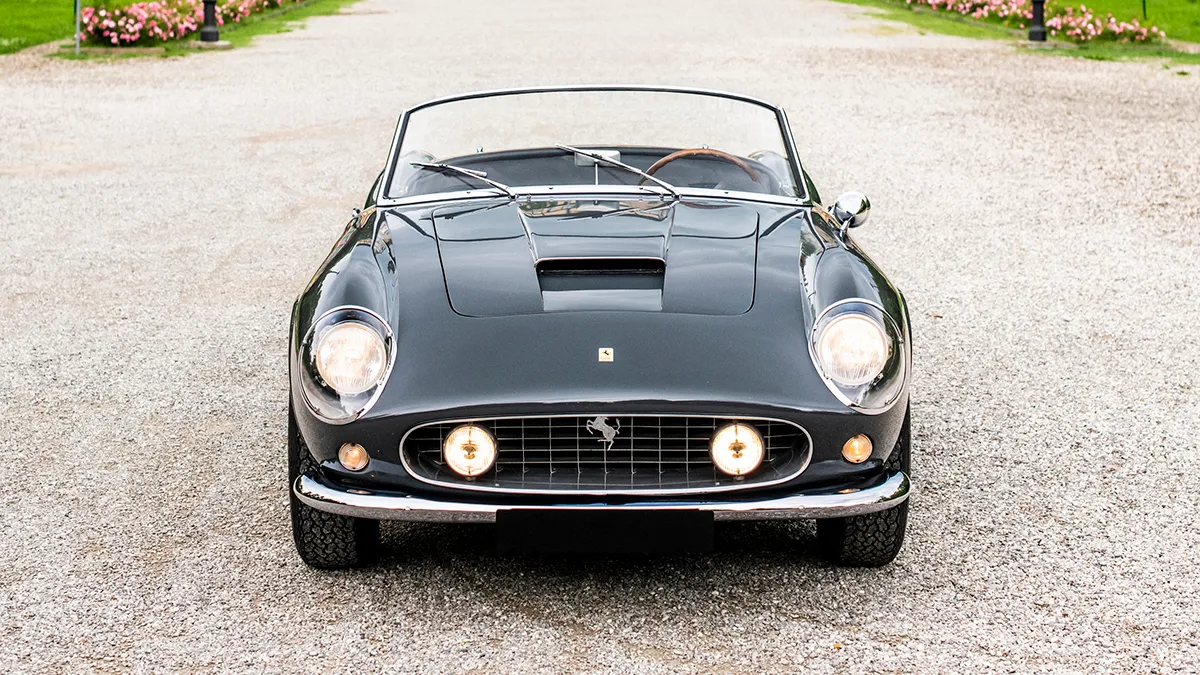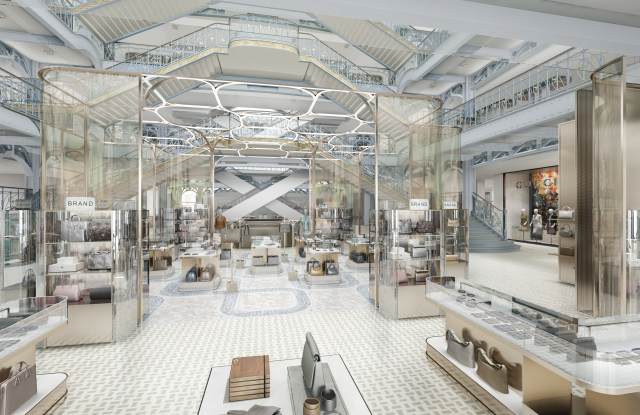
Robb Read: Recasting Retail In A Post-Pandemic Landscape
How the look and feel of shopping in stores is fast evolving in both temporary and permanent ways.
Related articles
Here’s the dilemma: Certain Covid-19-related adaptations to the retail setting might or might not be relevant in the future. It all depends on the impact of the pandemic on shopping behaviour and whether it lasts a year, two years — or much longer. That means retailers must be innovative, agile and resourceful to navigate the challenges posed by the global health crisis and its accompanying economic fallout.
In any case, the playbook for store design and the shopping experience is being rewritten by the coronavirus, forcing retailers to make immediate adaptations for social distancing and sanitising, while accelerating changes already in motion, such as buy online, pickup in-stores or curbside, and showrooming.
We asked experts in brick-and-mortar retail design to discuss their visions for the store of the future, whether it’s retrofitting for right now, or dramatically rethinking the space for the next generation. For many, it’s all about merging hospitality and retail, increased web functionality to link shoppers to inventory in local stores, easily cleanable surfaces, modified customer traffic flow, open spaces with less inventory on the selling floor, shopping by appointment, and flexible fixtures so product displays and shops-in-shop can be readily assembled and disassembled like stage sets.

Peter Marino Manolo Yllera/Courtesy Photo
Peter Marino, architect
“A condominium project I’m working on specifies an elevator with voice command, so you don’t have to touch anything metallic. It’s very eerie. It’s the touching aspect that’s questionable. The reason people go to stores is presumably to touch and try on the merchandise. I think it’s going to take a while to regain confidence in that.
“I think we’ll want everything more modern. I don’t want doorknobs to enter a fitting room — we should just be able to push the door. There will be a lot less touching of metal and small items, but architecturally the changes are not very much.
“After the Depression of 1929 and 1930, everything became simpler. All those gorgeous luxury apartments by Rosario Candela on Park Avenue were suddenly being built with no oak libraries, no oak trim around windows. There will be a significant drop in the use of luxurious finishes. It’s not appropriate in the face of so many deaths and so much monetary loss. Everything we’re doing or planning on will be much simpler, more elegant; we’re even sardonically referring to it as ‘coronavirus aesthetic.’
“I’ve always liked doing very sensual, textured walls. But you don’t want people touching walls anymore, and people don’t want to. There will be a much simpler approach. Certainly less sensual, potentially a little simpler for trends in the next three to five years.
“Recently, I’ve been using cheerful colours including yellow, orange and bright burnt amber for retail. I think that happiness factor will not change. People need to be cheered up.” — Miles Socha

Norman Roberts
Norman Roberts, design director, FRCH Nelson
“We are only partway into this so we don’t really know the long-term and short-term impacts are,” said Roberts. “But we do know that retailers will have to really satisfy customers when they come into the store. The hurdles to get people in become even greater than before.”
Roberts envisions retailers creating more space to give shoppers elbow room and easier navigation, adapting the brick-and-mortar experience to accommodate those shoppers who want to come and go quickly, and those who prefer to leisurely browse through.
“People will have different comfort levels,” observed Roberts, noting that some shoppers will be anxious in a large busy space and will want to get in and out fast; others will feel comfortable, and potentially shop like they did before.
“Part of this will revolve around communication and a lot of signage about express lanes, or full-service lanes — formats we have seen in gas stations and fast food. Retailers must have multiple ways to engage. You could easily drop a self-checkout into any shopping environment. But you have to do a good job of communicating. You will see a lot more overt signage in stores, around the health precautions being taken and informing people about shopping options. This will impact the aesthetics of the space.”
Roberts said retailers in the future will create more spacious environments, and retrofit by reducing the number of fixtures, displaying less merchandise, and even bringing some of what the store offers inside, to outdoor settings. “I could see retail starting to push out to the parking lots and sidewalks, restaurants extending outside, and stores opening up a little more to engage with consumers who don’t want to go into the stores.
“I can see fixtures coming out to the street, and pop-ups in parking lots, depending on the season and climate. People are going to want space and fresh air. One of the big unknowns is HVAC systems. What role will mechanicals plays in the store of the future? There is really not much information on the role they play in spreading the virus.
“Aesthetics-wise, retail is moving to a ‘less is more’ philosophy. Spaces will be minimal, simpler and flexible with open floor plans without designated aisles. An uncluttered, simple space feels comforting, from a cleanliness perspective, and it’s easier to clean. There are a lot of stores that have don’t have the right infrastructure. They need more flexibility.
“On a psychological level, for people coming out of their cluttered, chaotic homes, it’s going to feel very satisfying. You want a big, open floor plan so you can move around, and if you have aisles, you can add directional decals,” so people move in the same direction to facilitate socially distancing.
Furthermore, “A minimal, simple space will be a much better canvas to communicate information on safety, distancing, cleaning, how you check out, where to find men’s clothing, where to find the fitting rooms. There are a lot of new ideas retailers will have to communicate to people.”
With the fitting rooms, “Retailers must make them comfortable. It’s also all about sanitation. A lot of fitting rooms are not very well lit and feel a little icky.”
There’s also a bad feeling around cash, that it can transfer the virus. People no longer like to touch money, or stand at the checkouts where people interact in close proximity, Roberts said. “The use of self- and mobile checkouts is going to accelerate. But self-checkouts need to be easier to use.”
With the country in recession, “retailers are going to have to be very efficient with their dollars,” said Roberts. “A lot of what retail design firms do is retrofitting” rather than completely renovating or overhauling the box.
“We also have to keep in mind that with the recession in general, there is a self-consciousness around flamboyance and extravagance. We are entering a minimalist time. Ten years ago, we saw that happen. The merchandise radically changed. People became self-conscious about being too flashy about what they bought and wore. It’s like what happened during the Great Depression. It killed a lot of Roaring Twenties flamboyance.” — David Moin

Ron Radziner Courtesy Photo
Ron Radziner, design partner, Marmol Radziner
“Retail will become even more gallery-like. You see the item of clothing but there is only one piece, or one of each colour hanging, and if you want to try that on, the staff will go grab your size, and put it in the dressing room.
“My sense is the whole dressing room experience will also become more important. You could go online, to Tom Ford, and say, ‘hey I’d like to try on that suit, these shirts,’ and then you have an appointment and they have it ready for you, so there are fewer people in the same space at the same time. Maybe it’s your salesperson stepping into what the clothes look like on you, and you do your whole transaction from there.
“In most cases, when you go into The Row or Tom Ford, even James Perse, there aren’t that many people in the store anyway. So to imagine a transformation like this doesn’t seem that hard. The store doesn’t have to get bigger, there will just be a little less open shopping space, and a bit more on the dressing room side. You’d create a better fitting room experience that doesn’t have the narrow hall with a bunch of rooms, but is something more gracious. You may see another person as you go in and out but barely, you’re within your great room, maybe it becomes three to four times the size it is now.
“We did the first stores for Vince, and that’s different; it’s really nice stuff, but it’s more stuff. I wonder if stores like that or a bookstore are going to have to say the direction of traffic is this way, like Ikea. It will be about guiding people visually with how the shelving and the fixturing is set up. And certainly, in offices and restaurants, too, it’s about spacing between tables and counters. In L.A. we have lower density, but it will be especially difficult in a place like New York, where space is more of a premium.” — Booth Moore

OMA worked on the Galleria Gwanggyo, which opened earlier this year. Courtesy Photo
Chris van Duijn, partner, OMA
Shopping time slots. Open floor plans. One-way aisles. Less merchandise and subdivided stores for easier maneuvering. These are some of the adaptations stores are, and will be, making, according to van Duijn.
After the shutdown, people will be more inclined to enter stores with long sightlines and full overviews for a direct path to what they want, rather than going through narrow spaces putting people in close proximity to each other. Shopping malls and developers could incorporate social distancing by dividing one store into two to easily organize the goods on display.
“If you look at retail from where you are today, you could imagine less quantity, less occupancy [for shoppers], less physical interaction, less social, less vertical and maybe more quality and a more personal experience.
“How this works in the long term, I am a bit sceptical that people will really change their habits too much,” van Duijn said. “People are social animals and I can see them going back to their original habits.”
The OMA partner noted that in Asia, where shopping malls and stores have reopened, people wear masks and “that’s basically it.” Whereas in Europe, there will be greater physical change to stores, with layouts and how people circulate. “In Asia, the masks basically compensate for the social distancing. People are used to them. In Europe, it’s still very new. There is not that level of comfort with masks that there is in social distancing. It will be interesting to see how this behaviour affects the coronavirus infections again and whether there will be more waves.”
Given the need for social distancing, the social aspect of shopping is changing. Consumers may not bring family members or friends along. “It’s no longer a social experience that you enjoy and hang out,” van Duijn said.
Having designed The Galleria, a department store that opened in late March outside of Seoul in Gwanggyo, the OMA partner said changes have not been requested. At this point, the pandemic has changed consumer behaviour and the number of goods being produced and those factors may change retail layouts, he said.
“Brands will probably produce fewer goods. Some of the luxury brands have already said that for 2020, we won’t do any more. We will see you back in 2021,” he said.
With fewer designs and less production, developers, department stores, specialty stores and shopping malls will need to adapt, van Duijn said. “What’s interesting is the urge to buy things became much less in a very natural way. People, obviously, shop more online. That’s logical. But you shop for what you need and not so much for fun. Morally and ethically, that is good but at the moment that will not help our economic system. There will be many victims there.” — Rosemary Feitelberg

Glenn Pushelberg and George Yabu of Yabu Pushelberg Courtesy Photo
Glenn Pushelberg and George Yabu, Yabu Pushelberg
Pushelberg: “As a result of social distancing, the scale of stores will remain large or grow larger, made possible by what will be affordable real estate. In a multibrand store, I believe there will be more compartmentalization, going from room to room in a graceful way that simultaneously controls traffic and creates intimate brand experiences. La Samaritaine, a department store we designed for LVMH in Paris, is by circumstance well suited for this new future of retail. The aisles aren’t deep, and they don’t have the traditional floor plates of a department store. Aisles are narrow as a result of the heritage atrium building that houses the store. Subsequently, traffic flows in an upward ring, moving guests vertically from one shopping area to the next.
“At the end of the day, retail is a form of entertainment. It’s an opportunity for something experiential, and I believe there will be a cautious movement back to retail as a form of entertainment.
“It won’t be the speed of shopping or the efficiency of it, it will be the form of it. There have been some retailers such as Maison Kitsune, for example — they’ve built a café, where they produced the music. To me, the next step is a place you can sit down and have lunch, buy the music, leisurely look at the clothes or have the clothes come to you in a larger restaurant.
“Restaurants in their traditional sense aren’t going to work well either because people will need to be spread out, but if you can add more experiences and add on to the purchases, you can actually make something that works. To me, there will be more blending.”
Yabu: “People want to return to stores and make purchases knowing how and why something was made the way it was. Perhaps at some point with the way real estate will be changing, allowing for more expansive retail spaces, the start-to-end experience can be a little more drawn out and people can also experience the craftsmanship behind what they’re purchasing in this multifaceted destination.
“Years ago, we were working on the VIP rooms for some of the Louis Vuitton shops and they took us through their workshops, and to us, the workshops were fascinating. I was almost expecting a store or restaurant to be part of the workshop. To me, that whole thing can be combined.
“We designed a store for Lane Crawford in Beijing for a family looking to essentially create their own small-scale shop in the sense that it would allow for semi-private shopping. Even though the store was open to the public, there were times the client wanted the option to invite friends to shop without other guests sharing the space. We created subtle ways of closing off shopping areas with the use of folding doors, similar to those which may be found in a graceful European home. You get a sense that there’s a room beyond where you stand; however, you must be invited to enter. A similar concept could be put in place moving forward to orchestrate traffic flow whilst still enhancing the shopping experience.” — M.S.

Robin Kramer
Robin Kramer, founder, Kramer Design Group
“Everything that would have happened in the next three to five years will be happening in the next three months. The health crisis is definitely causing people to be much more creative, to think outside the box, and not hold onto old thought processes. But what makes retail great are the simple things we need to go back to — great merchants, great assortments, edited fleets.
“My company has always been focused on the customer experience, and now it’s how you make the consumer feel comfortable going into a store, touching things, trying on things. You have to be incredibly creative to offer new solutions without losing your brand image, whether it’s curbside pickup or logistics, how do we stand out and do it through the lens of the brand? Curbside pickup at a grocery store needs be very quick and efficient. At Bottega Veneta, it might be very different, involving more customer service, a deeper thought process.
“With the beauty store for the future, how do you look at testing and servicing customers in something as intimate as beauty? We are working on a new concept for a multibrand retailer which will contain beauty, wellness and health.
“Even in ready-to-wear, the opportunity is service. Bergdorf Goodman can take high-end service and personal shopping to a whole new level.
“Jewelry is ripe for the next innovation. No one’s reinvented the jewellery store format. It’s something we are looking at — how you change the jewellery experience. It’s not enticing to go into a store and be limited by that caseline. It’s been too precious of an experience. High end needs to be more accessible without losing its sophisticated appeal.
“There is also an opportunity for merchants to bring travel to the consumer. Remember when it was a big event to go to Bloomingdale’s, and see how products from different countries, like India, permeated every department in the store? With less travelling now, merchants should be creative by bringing the world to you through their merchandising.
“We can already see as Europe reopens that people still want to shop in stores. Precautions like masks, hand sanitizer, distancing will be put in place, though people will still want to touch and try on.”
Among Kramer’s recommendations for the store of the future:
• Edit and focus assortments so shoppers don’t have to plow through tons of products.
• With checkouts, the more touch-less the better.
• For dealing with taking clothing off the selling floor for cleaning, keep more stock in storage and less up front, and have sufficient service for retrieving what’s requested in short order.
• “Inspire” customers to buy beauty online and encourage trying new products at home. Offering a discount on the next beauty product ordered would help.
• Create areas for service that provide privacy; fitting rooms must be as comfortable as possible. — David Moin

Joan Insel Courtesy Photo
Joan Insel, vice president of brand strategy and customer insights, CallisonRTKL
“We are in the improvisation phase. This is a very dynamic and fluid environment.”
Retailers, she said, while beginning to adapt their store environments to new health requirements and precautions to reduce the risk of being infected and encourage shopping “also have to think about long-term strategies. Stores really need to be flexible and agile to be ready for a lot of change. From an aesthetic point of view, retail design will certainly have to make people feel safe and secure. Emotions are paramount right now. How do you make employees and customers feel safe?
“You are going to need more space, and to reduce the number of fixtures. We are starting to ask the question of what is the purpose of each space. In the past, we wanted people to linger and create a community.” Now, at least until there’s a vaccine for COVID-19, a degree of separation, social distancing, prevails.
“There is this whole idea of spatial repurposing — parking lots that transform some space into pop-ups or drive-in movie theatres, or event spaces where you stay in your car. Mall parking lots are huge and can repurpose a vast amount of space.” That could involve more personal service by employees greeting customers in their cars, at a distance, Insel added.
“With drive-through experiences, how can we make them more of an opportunity for a specific brand, whether it’s REI, Nike or Nordstrom,” among the retail clients that CallisonRTKL has been working with, along with Tiffany & Co., Burberry, Louis Vuitton, Target, Cotopaxi, böhme, Citi, Toys ‘R’ Us, and ABC-Mart Grand Stage. CallisonRTKL was a design partner for Nordstrom’s Manhattan flagship on 57th Street in Manhattan, working in conjunction with Nordstrom’s design team.
“Density used to be a good word. Now it’s a bad word. Who’s driving downtown anymore? Smaller stores is also where we are heading towards. It’s already been happening. Small is the new big, so you can go to where the customer is and not necessarily having the customer come to where you are.”
Among Insel’s other recommendations and considerations for operating and adapting the retail setting:
• Showrooming, so there’s more space and less inventory on the floor to facilitate social distancing.
• Have fixtures that can be lowered from the ceiling or raised, depending on the product display. Fixtures should be portable, and packable, to readily assemble and take down fashion presentations and exhibits “almost like stage set design.”
• Flexible floor formats, without carpet pads, so areas can be easily enlarged or downsized depending on selling trends.
• Redirect traffic and customer flow, determine what occupancy levels seem safe.
• Integrate voice command like Alexa or Siri and mobile apps to get directions to the items or department you want, to limit meandering through the store. The technologies could also be used to request services, or adjust fitting room lighting.
• Virtual, augmented and mixed reality to see how you look in different outfits or cosmetics without trying anything on or applying any makeup.
• Contactless payments, such as Alipay.
• Automatic doors. — D.M.

Coren Sharples Courtesy Photo
Coren Sharples, a founding principal, SHoP Architects
For the store of the future, establishing a sense of community and personalized experiences are increasingly important, said Sharples. “We don’t need a physical space to sell things. Obviously, we’re doing this all the time without a physical space. We can move volume online, through Amazon — anyone can do that. We need physical spaces to have the experiences. Stores are really going to be much more about places where you can connect and strengthen relationships and experiences.”
One of her projects, The Company Building at 335 Madison Avenue in Manhattan, is being renovated and repositioned as a tech hub for start-ups. Located a few blocks from Grand Central Station, The Company Building once housed the two-floor Daffy’s off-price store, which was “walled off from the rest of the building,” Sharples said. The new retail component, which is the next phase of the development, will be easily accessible.
Rather than target a big-box tenant, a marketplace is being created. “The idea is that this is an extension of the start-up community in the building,” Sharples said. “We completely opened it up to the lobby and added an extra floor, so it’s part of the experience of the building.” The space could be used by start-ups for product demos, focus groups or pop-up shops. “It’s about community, small-scale, adaptability and low-barrier entry,” Sharples said. — Rosemary Feitelberg

Mike Riggs Riggs,Mike & Jenna
Mike Riggs, managing director of retail, IA Interior Architects
“From what we’ve heard from our clients, it’s not necessarily a revolution at retail. It’s probably going to be an evolution of those changes that were already needed. Most of the plans we’ve seen from retailers are table stakes — enhanced cleaning, no touch, identifying those who may or may not have the disease, social distancing, spacing, occupancy, how many people you can have in the store. Materiality will likely be more considered,” to identify what the virus lingers on. “I think [store experiences] will be driven less by regulations and more by consumer behaviour. “Concepts we have been talking a lot about leading up to well before COVID-19, I see it really taking hold now — retail brands connecting to the consumer within the physical store environment by evolving more from consuming goods to doing good — this brand altruism. For both Nike and REI, it does affect the design of the store. Maybe we find areas that speak to the community with some celebration of their guests in the locale or region,” who get involved in making a difference in the community. “Having these [aspects] in their environments allows consumers to embrace their tribal tendencies, the desire to be together, to do something good and to be able spread the word of that same goodness.
“There are some real positives that can come from this [pandemic] as opposed to how we are going to be six feet apart from one another in a bubble spraying our hands with bleach every five minutes.”
Also for the store of the future, “VIP experiences might be the norm. Appointment-based shopping and how that might extend and be less elite,” said Riggs.
And for those picking up online orders in the store or curbside, “It will be interesting to see how that all plays out. It’s growing but very slowly in my opinion. There is this idea of people still wanting social interaction and to see other people. The pickup at the curb I think will have a limited lifespan. There are a lot of specialty retailers dependent on impulse shopping. So how do you create an in-store experience that allows people to maybe surveil what is immediately adjacent to the entry and allows guests to see much of the store presentation, while picking up [online orders] in store. How do you make that bridge from pickup to browsing?”
With the retail box, “It used to be about big and small versions. I see extended versions in different, regionalized ways, connecting to different levels of interest in different formats. Focus on these five things that are really important” to a particular community, said Riggs. “I do think people in this COVID-19 current state, just need to be out and to connect. The more retailers create really unique, compelling formats, the more likely they will make that happen. Consumers are going to be really demanding, post-COVID-19, from an emotional standpoint.” — D.M.

Barbara Bestor Courtesy Photo
Barbara Bestor, principal, Bestor Architecture
“We were doing retail concepts for big sports retailers, and they are seeing their stores less as stores and more as places you see sanitized samples, then go home and have the goods shipped to you. It also wouldn’t be hard for a smaller store and would allow you to not stock as much. The whole trend for larger retailers to stuff everything full, and always have 30 sizes of everything [displayed], that’s probably long gone.
“You will have a little more of a concierge aspect to retail, too, where it’s someone’s job to put the sample that’s been tried on away somewhere for 24 hours, so you would need space for racks that are time-stamped. There’s going to need to be more room for infrastructure for people spritzing down and cleaning, a little more like food retail where you have to obey certain retail codes.
“Another thing is materiality. We can do some things with terrazzo, and other surfaces that are more solid and cleanable than wood — stuff you can wipe down. A lot of the work we have been doing is third-wave coffee shops, that might translate into other retail. It would seem to be better in general for health if things are concrete and metal. There’s going to be an innate psychological aspect, the idea that your design looks safe, and feels clean and uncluttered. They say the roots of International Style and European Modernism was a reaction to the first Spanish flu, and the idea of the sanitized hospital as opposed to the slums of Paris, I would see how that would come back as a design style that reads as hygienic. One good example is the new Webster store in L.A. by David Adjaye. It’s all pink concrete and looks like it could be hosed down.
“Also, openness — it’s already a huge design trend. I don’t know how much indoor malls will survive, but I could see more tearing the roof off. I could also see more local delivery, a local boutique could drive around the neighbourhood with a dress mobile! That’s something Amazon can’t do.” — B.M.

Shayne Brady pictured at Bob Bob Cité in London, which he designed last year. Courtesy of BradyWilliams
Shayne Brady, cofounder, BradyWilliams
“We are going to see a shift towards an even more personalized service with stores offering customers reassurance that their needs and concerns are being heard, while also offering a luxury experience to entice them to come into the store, not just shop online. Retailers will need to offer the usually exclusive one-on-one consultations to a broader audience in order to create a more customer-focused, brand-facing experience.
“We can imagine brands will offer a by-appointment-only service with slots allocated through mobile apps. This is where the digital and physical collide to allow people to immerse themselves in the brand, engage with customer service and experience the products.
“The introduction of private or semi-private rooms could be created through removal of traditional open floor plans, moving the product from the shop floor into individual categorized capsules. In our forward-thinking vision we have come up with perfectly spaced consultation rooms that allow customers and staff to be safely placed, while the introduction of partial screens means there is still a sense of interaction and personalization.
“As we come out of lockdown, an important factor is to strive for a greener, more sustainably aware world. The planet has started to slowly reset elements during lockdown and the need to continue this is of paramount importance. This is certainly something that brick-and-mortar retail destinations need to consider in our new world.
“Locally sourced materials will be key; designers should be sourcing materials from accredited suppliers to ensure we are giving back and not further harming the planet, whilst also ensuring that we are careful that the emissions produced in the manufacturing processes of the materials is also not causing further damage.
“Customers will likely crave interaction and the elevated service that only comes from shopping in real life. However, there will also be a sense of caution and safety that retailers will need to offer, whilst not making spaces feel clinical or losing the brand identity. The key to successful luxury retail is the total immersion of a customer within the brand. There are ways to do this through the addressing of all our senses, including smell, within the store, the careful choice of materials and a sense of craft to represent the overall ethos of the brand.
“I’ve always been an avid fan of how a certain smell can immerse someone in a fond memory or evoke a certain feeling. Often brands will have their own synonymous smell and so by ensuring that using diffusers to permeate the air, a memory is created in the sensory brain of our bodies. This will also enforce the brand and elevate the overall experience, again encouraging people to step out from behind their screens and into the shop.
“Retailers must vitally consider using materials that prevent the spread of germs. A key point in all our designs is the front-door handle which sets the tone for the design. Moving forward, we recommend using metal door handles in a copper alloy as this material helps to reduce the spread of germs, protecting customers. Also, we think nonporous and lacquered materials, that allow for frequent and more easy cleaning, will be key.
“In our imaginary accessories store, we have developed a concept of personal shopping meets online shopping. Set in the likes of Dover Street Market, we have created the idea of an indulgent model of personalised capsule pods. Designed to allow a customer to safely experience all that a brand has to offer, these immersive pods would be filled with a thoughtfully chosen aroma and indulgent yet nonporous materials would be used.
“We want to instil an old-school sense of craftsmanship. Retailers should look to turn their backs on the hype of mass purchasing whilst encouraging customers to buy key items. This needs to be reflected in the interiors, which should feel crafted and bespoke, using pieces that will be purchased as an heirloom.
“Floor staff, whilst protected behind a privacy screen, will still have clear interaction as they assist customers in choosing items from the dramatic vertical conveyor belts behind — we love the idea of the machine at work juxtaposed with the craft of the capsule.
“We have imagined integrated safe-deposit boxes lining the walls, allowing customers to peruse sunglasses while the sales staff can safely unlock each remotely, allowing a customer to experience and try them on.
“In our forward-thinking approach to retail, we are elevating shopping to a piece of theatre, whilst keeping customers and staff safe and reassured.” — Samantha Conti

Silvia Kuhle Courtesy Photo
Silvia Kuhle, cofounder, Standard Architecture
“It will probably look different for different levels of clients, depending on if it’s a store for a broader public versus a more high-end, couture or home store. If it’s broader, a lot of browsing would happen online, and inventory will be closer linked to your local store, so you don’t just browse online general merch, but make a basket of things to try on from whatever your local store has, then make an appointment. That could happen even in stores that exist now. If you cut out browsing, you can still service a lot of people in stores you have.
“While you have some stores that are completely open, others like to create rooms within the store, and each one has a different environment or decoration, so you are in an evening area or men’s or beachwear area. Maybe each area is just for one person or one group, to ensure safe browsing, and you’d walk in a circle through all the rooms —like Ikea but in a much nicer way. If you feel like you are by yourself, you feel OK browsing around.
“I could also see high-end stores becoming about personal shopper appointments where you are the only one in the store. Changing rooms have to be cleaned after every shopper. Everyone will need a washer/dryer in their space, and maybe you pick up your own personal mat or cushion (they already do that at the gym), in addition to a branded mask and gloves, when you enter the store.
“And the store experience will have to be linked in an intelligent way with the Internet, maybe with a chat feature that doesn’t just go to someone in a call centre, but a person in your closest store.” — B.M.

Pamela Shamshiri Dewey Nicks/Courtesy Photo
Pamela Shamshiri, cofounder, Studio Shamshiri
“I think people are going to consume less, but specialty and high end will continue and the retail experience will be more about visiting ateliers and studios by appointment. We were already moving toward everything feeling residential, at least I was, but it will just be that next layer of privacy and point of view that’s more curated and personal and has less volume of people.
“It may take longer to shop, for special orders and for things to arrive, but maybe that will make things more coveted. As for design elements, I think a kitchen and living room, more bespoke interiors, a whole world where you can spend hours and hours, then buy things, more like a merging of hospitality and retail, like an artist studio visit and by the way, the bread was so good. You can relax and take your time. I just finished [L.A. jewellery designer] Sonia Boyajian’s store and her concept was by appointment, where you can see everything being made. It’s like a small factory.” — B.M.

Torquil McIntosh and Simon Mitchell, cofounders of Sybarite in London. NOAH SHELDON
Torquil McIntosh and Simon Mitchell, cofounders, Sybarite
“In the immediate aftermath of COVID-19, stores will need to initially allow more space per customer to anticipate…what they will need to feel comfortable in their own skins and secure within the given environment again. Retailers should consider social distancing within the stores and embrace it as a positive, change the store layout to create pockets, meaning that larger volumes of people can filtrate and shop at ease. You could really fly with this concept and create bursts of experiences along the way.
“Smart retailers [will] allocate time and funds to reevaluate and reassess store strategies and store experiences and make them more exceptional, more of a spectacle. If they are able to implement them in time for their reopening, they will reap the rewards. In addition, self-quarantining will bring a renewed passion for real-life experience and occasion rather than the comparable flatness of e-commerce. This will be a cue for visual merchandising.
“There will be a shift in the importance of cultivating homegrown support and celebrating niche producers. A sense of rediscovery is what lies ahead. The restrictions that have been experienced with global travel have resulted in an invigorated resourcefulness. There will also be newfound respect for the products themselves and the ability to view them in an environment away from ‘home.’
“Customers will, most likely, become more discerning post-COVID-19. Stores will need to work hard to offer something that is radically different to digital since the world has become accustomed to it during these pandemic days. Customer service will need to be on tap to match client expectations and over and above e-commerce levels.
“Brands and retail designers are always looking at better ways of communicating their brand offerings, and it is likely that COVID-19 would have propelled them into looking into this with a heightened and more accelerated incentive. Seamless shopping experiences where hygiene and tech are expertly designed into the environment are always top priority, although the boundaries are always looking to be pushed.
“Innovation and purposeful design will be front of mind and emphasized post-COVID-19, as will dedicating more surface area to a smaller edit of products that can be viewed in a different way, rather than packing in larger quantities of goods. Storytelling and sense of place can never be underestimated.
“Luxury stores are always changing to create newness. COVID-19 will mean that retailers will look at how to future-proof environments. Agility in thinking, in business, in design and in luxury is the key to the survival of the fittest and the bravest. Luxury goods will continue to focus on experiences, the storytelling aspect around purpose and values, heritage and authenticity in order to remain relevant.
“Customers will want to buy into something which clearly demonstrates source and accountability and responsibility amongst brands. The phenomenon and the intricate subtleties of experience, sensation, touch is everything. There will be a need for the experiential, with more space and fewer products.
“Stores will be looking to curate an experience that is remarkable and that resonates well beyond the store itself. The store acts as a catalyst, a platform.
“The allure of the brick-and-mortar experience is essential as the differentiator and acts to promote brand solidity. The goods and physical environment are designed to make one feel good and therefore hold more currency than ever, something to covet and look forward to.”
There will be “a blurring of boundaries between straight retail acquisition and retail acquisition surrounded by a level of theatre in terms of exhibition/art installations, dining, drinking and sleeping. Case in point is SKP-S, Beijing, a collaboration between Sybarite, SKP and Gentle Monster where art installations and Future Farms and space tunnels weave their way around the forward-thinking curation of products.
“Retailers should reveal what they would usually hide — prove that they are the best in air quality and ventilation with a filtering [system], for instance. Display the air renewal system in a glass box, akin to an installation, for all to see in plain sight as a focus point — make it part of the experience.
“Allow people to be able to check and follow it — the ultimate in transparency. Air filtering should be a core consideration; this should be increased in line with the medical industry with the certification to boot. A small sacrifice in surface floor area which could be retrofitted into an existing A/C system. This could become the USP of a given store. Health is the ultimate luxury.” — S.C.

Geraldine Wharry
Geraldine Wharry, futurist, designer and educator
“There is a type of a state of panic right now. People want answers — immediate answers. There are no easy answers in terms of retail unfortunately and the gatherings of people. [Retailers need to] focus on the difference between short-term measures to prevent the spread of the virus and to protect consumers and workers, and then long-term solutions that would benefit the already struggling retail landscape. [That could] possibly be considering more sustainable solutions, experience and wellness.”
While heatmap cameras, motion sensors for doors and digital try-ons may be increasingly used for health precautions for shoppers, Wharry spoke repeatedly about how retailers need to also take a long view about the future of retail.
“The store of the future is a store that will hold stock in a very intelligent way. It will be highly personalized and focused on the social experience rather than just selling goods. Everyone can get that online,” she said.
She pointed to the customized selection made possible by Nike Live’s “Nike by Melrose,” a fusion of an online and offline store. Wharry noted how shoppers were required to sign up for the Nike Plus app to unlock services and perks in the store. By doing so, Nike learned about each customer’s shopping behaviour and preferences, and stock was adjusted accordingly, Wharry said. That eliminated the need for overstock or regular sales, she said.
Wharry also singled out, The Westfield London’s Trending Store, a pop-up that used AI to analyze social media data to extrapolate the top 100 fashion items. Each morning a team of stylists culled the trending items from retail stores in the mall. “Data and analytics will be really great to help have a real curation of a store. People are not going to want to spend hours in a store. They will want to know what they’re coming for — potentially in the beginning until things get back to normal.” — R.F.
Lewis Taylor, design director, David Collins Studio
“Retail spaces will inevitably need to work harder in terms of their design, materiality and the narrative that these things create to engage with their customers. Before the current pandemic, customers had become more demanding of brands and more critical of any perceived lack of authenticity, and this will continue.
“Customers will want to feel that their personal privacy, safety and security is continually being managed as the situation changes going forward, and again, what is the right fit in one territory may not work in another. It goes without saying that very visible, and brand-appropriate hand-sanitizing stations should be available in all stores, and the measures put in place with regard to social distancing will need to be in line with local regulations. This will need to be managed with very well-considered, in-store customer services and ‘hospitality’ – not just the staff the customer engages with on their journey through the store, but potentially the visibility of temperature checkers, of hygiene staff, and how they are dressed, or re-positioned within the store experience. How does a brand express that cleaning is of paramount importance ensuring that it is brand-appropriate and not alarmist? Similarly, how do you demarcate social distancing without destroying the design integrity of the store?
“There will inevitably be an increase in personal and private shopping experiences that may allow for use of VIP fitting changing rooms or private spaces within stores that can be managed with a well-considered hospitality strategy. These relationships have always been key, and were a large consideration when David Collins Studio designed global retail roll-outs for brands Alexander McQueen, Jimmy Choo and de Grisogono, building the ceremony of service into the design and functionality of the store experience. David Collins Studio designed a private bridal space for the Jimmy Choo Townhouse on Bond Street, and VIP fitting rooms at Harrods in both men’s and women’s wear departments at Harrods, and these stores that have the luxury of these spaces will be able to build them into their private shopping experiences. Brands that already manage their brand story, store design, sales strategy, and have a robust CRM database will have a head start here.
“Pinch-points within stores will need to be considered in terms of the customer journey and managing the use of escalators and lifts. A lot of these considerations will be easier to implement within luxury stores rather than in high street stores, which are potentially more dependent on high traffic.
“Beyond COVID, the retail landscape has been changing for a while, with a more demanding customer seeking more authentic and well-considered shopping experiences in return for their brand loyalty. This situation might further push forward the sustainability agenda as a heightened sense of risk or threat permeates society and the economy, but ultimately if brands stick to what they do well, collaborate with the best teams, deliver the best in terms of design, craft and operations, and continue to invest in building a community within their your client base, they will survive and succeed.”
Subscribe to the Newsletter
Recommended for you
Ode to Oasi
Ermenegildo Zegna wrote the book on dapper Italian style. Now, a new coffee-table tome pays homage to its greatest creation—one that, hopefully, will endure long after the brand is gone.
By Brad Nash
June 25, 2024
Everybody Loves Naomi
Fashion fans adore her. And so do we. Lucky, then, that a new exhibition is paying homage to the undisputed queen of the catwalk.
By Joseph Tenni
June 22, 2024
You may also like.
By Josh Bozin
24/07/2024
You may also like.
5 Lounge Chairs That Add Chic Seating to Your Space
Daybeds, the most relaxed of seating solutions, offer a surprising amount of utility.
Chaise longue, daybed, recamier, duchesse brisée—elongated furniture designed for relaxing has a roster of fancy names. While the French royal court of Louis XIV brought such pieces to prominence in fashionable European homes, the general idea has been around far longer: The Egyptian pharaohs were big fans, while daybeds from China’s Ming dynasty spurred all those Hollywood Regency fretwork pieces that still populate Palm Beach living rooms. Even Mies van der Rohe, one of design’s modernist icons, got into the lounge game with his Barcelona couch, a study of line and form that holds up today.
But don’t get caught up in who invented them, or what to call them. Instead, consider their versatility: Backless models are ideal in front of large expanses of glass (imagine lazing on one with an ocean view) or at the foot of a bed, while more structured pieces can transform any corner into a cozy reading nook. Daybeds may be inextricably linked to relaxation, but from a design perspective, they put in serious work.
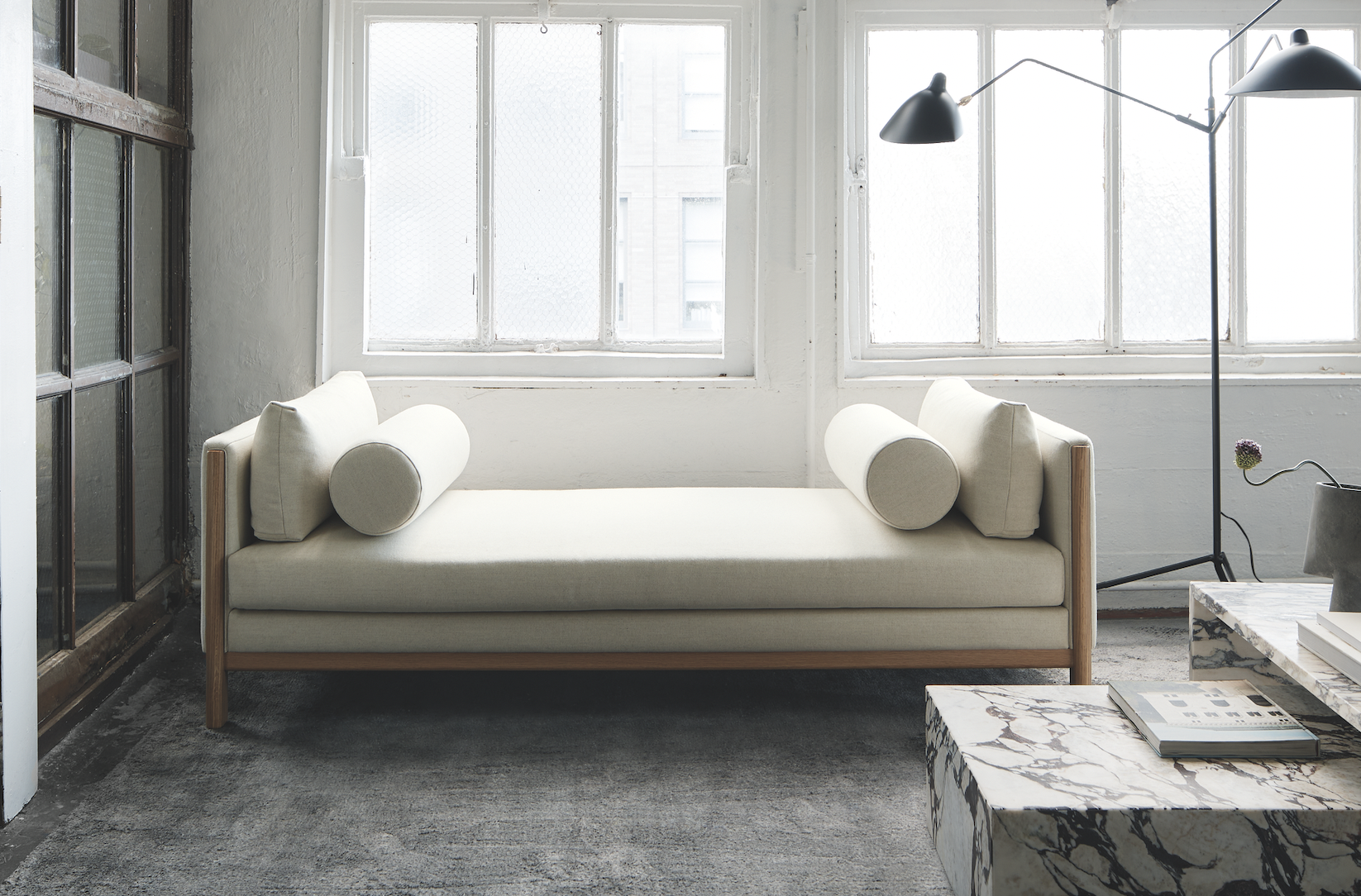
Emmy, Egg Collective
In designing the Emmy chaise, the Egg Collective trio of Stephanie Beamer, Crystal Ellis and Hillary Petrie, who met as students at Washington University in St. Louis, aimed for versatility. Indeed, the tailored chaise looks equally at home in a glass skyscraper as it does in a turn-of-the-century town house. Combining the elegance of a smooth, solid oak or walnut frame with the comfort of bolsters and cushioned upholstery or leather, it works just as well against a wall or at the heart of a room. From around $7,015; Eggcollective.com
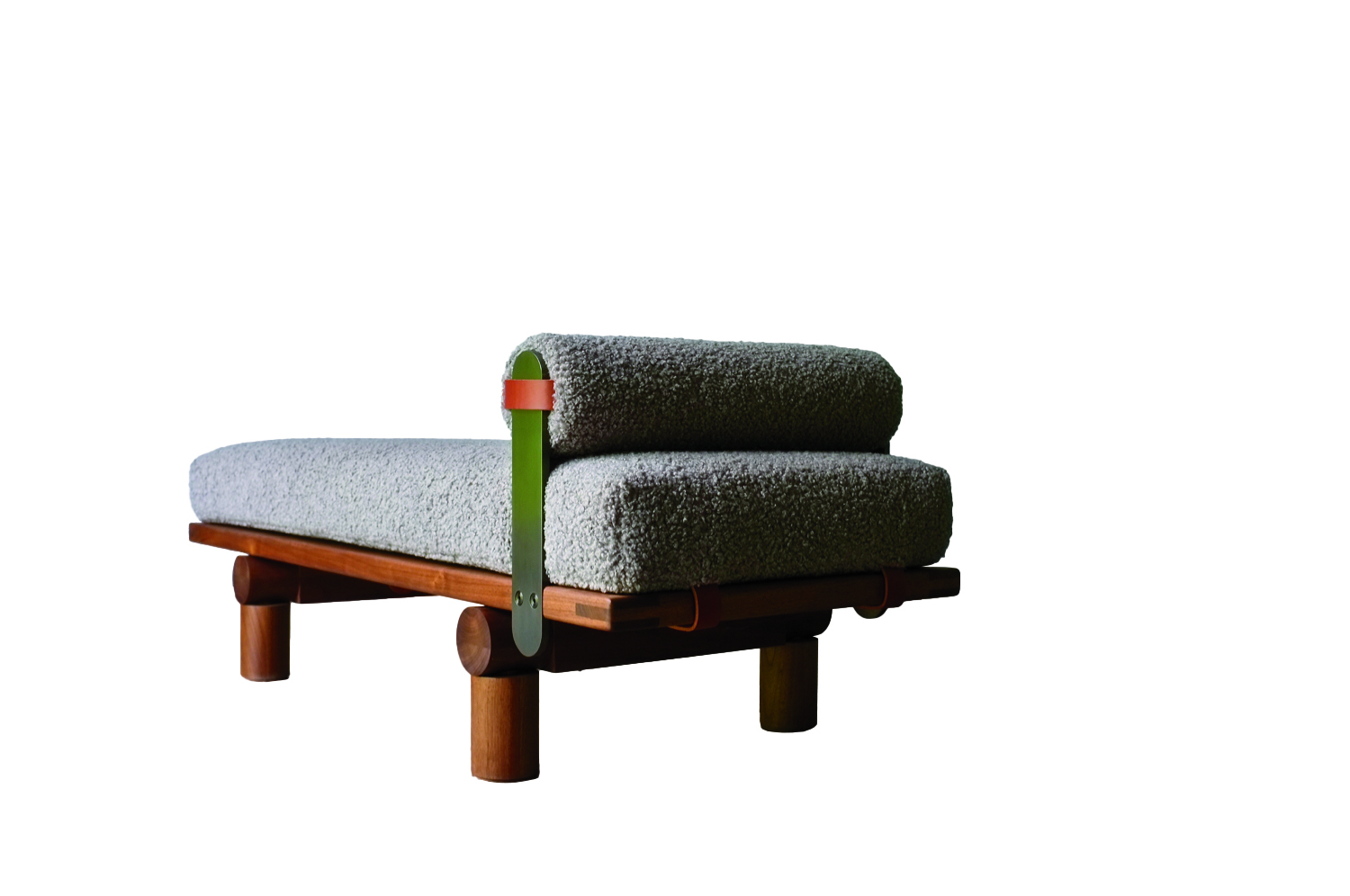 Plum, Michael Robbins
Plum, Michael Robbins
Woodworker Michael Robbins is the quintessential artisan from New York State’s Hudson Valley in that both his materials and methods pay homage to the area. In fact, he describes his style as “honest, playful, elegant and reflective of the aesthetic of the Hudson Valley surroundings”. Robbins crafts his furniture by hand but allows the wood he uses to help guide the look of a piece. (The studio offers eight standard finishes.) The Plum daybed, brought to life at Robbins’s workshop, exhibits his signature modern rusticity injected with a hint of whimsy thanks to the simplicity of its geometric forms. Around $4,275; MichaelRobbins.com
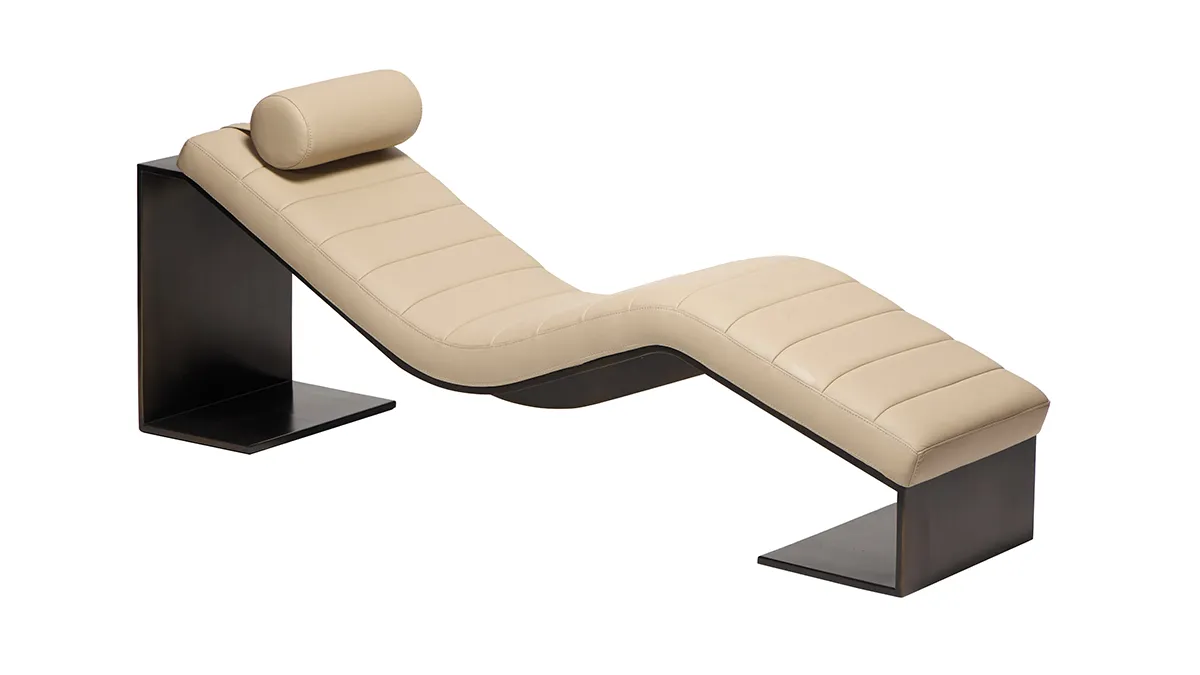
Kimani, Reda Amalou Design
French architect and designer Reda Amalou acknowledges the challenge of creating standout seating given the number of iconic 20th-century examples already in existence. Still, he persists—and prevails. The Kimani, a bent slash of a daybed in a limited edition of eight pieces, makes a forceful statement. Its leather cushion features a rolled headrest and rhythmic channel stitching reminiscent of that found on the seats of ’70s cars; visually, these elements anchor the slender silhouette atop a patinated bronze base with a sure-handed single line. The result: a seamless contour for the body. Around $33,530; RedaAmalou
Dune, Workshop/APD
From a firm known for crafting subtle but luxurious architecture and interiors, Workshop/APD’s debut furniture collection is on point. Among its offerings is the leather-wrapped Dune daybed. With classical and Art Deco influences, its cylindrical bolsters are a tactile celebration, and the peek of the curved satin-brass base makes for a sensual surprise. Associate principal Andrew Kline notes that the daybed adeptly bridges two seating areas in a roomy living space or can sit, bench-style, at the foot of a bed. From $13,040; Workshop/ APD
Sherazade, Edra
Designed by Francesco Binfaré, this sculptural, minimalist daybed—inspired by the rugs used by Eastern civilizations—allows for complete relaxation. Strength combined with comfort is the name of the game here. The Sherazade’s structure is made from light but sturdy honeycomb wood, while next-gen Gellyfoam and synthetic wadding aid repose. True to Edra’s amorphous design codes, it can switch configurations depending on the user’s mood or needs; for example, the accompanying extra pillows—one rectangular and one cylinder shaped— interchange to become armrests or backrests. From $32,900; Edra
You may also like.
By Josh Bozin
24/07/2024
22/07/2024
Watches & Wonders 2024 Showcase: Hermès
We head to Geneva for the Watches & Wonders exhibition; a week-long horological blockbuster featuring the hottest new drops, and no shortage of hype.
With Watches & Wonders 2024 well and truly behind us, we review some of the novelties Hermès presented at this year’s event.
—
HERMÈS
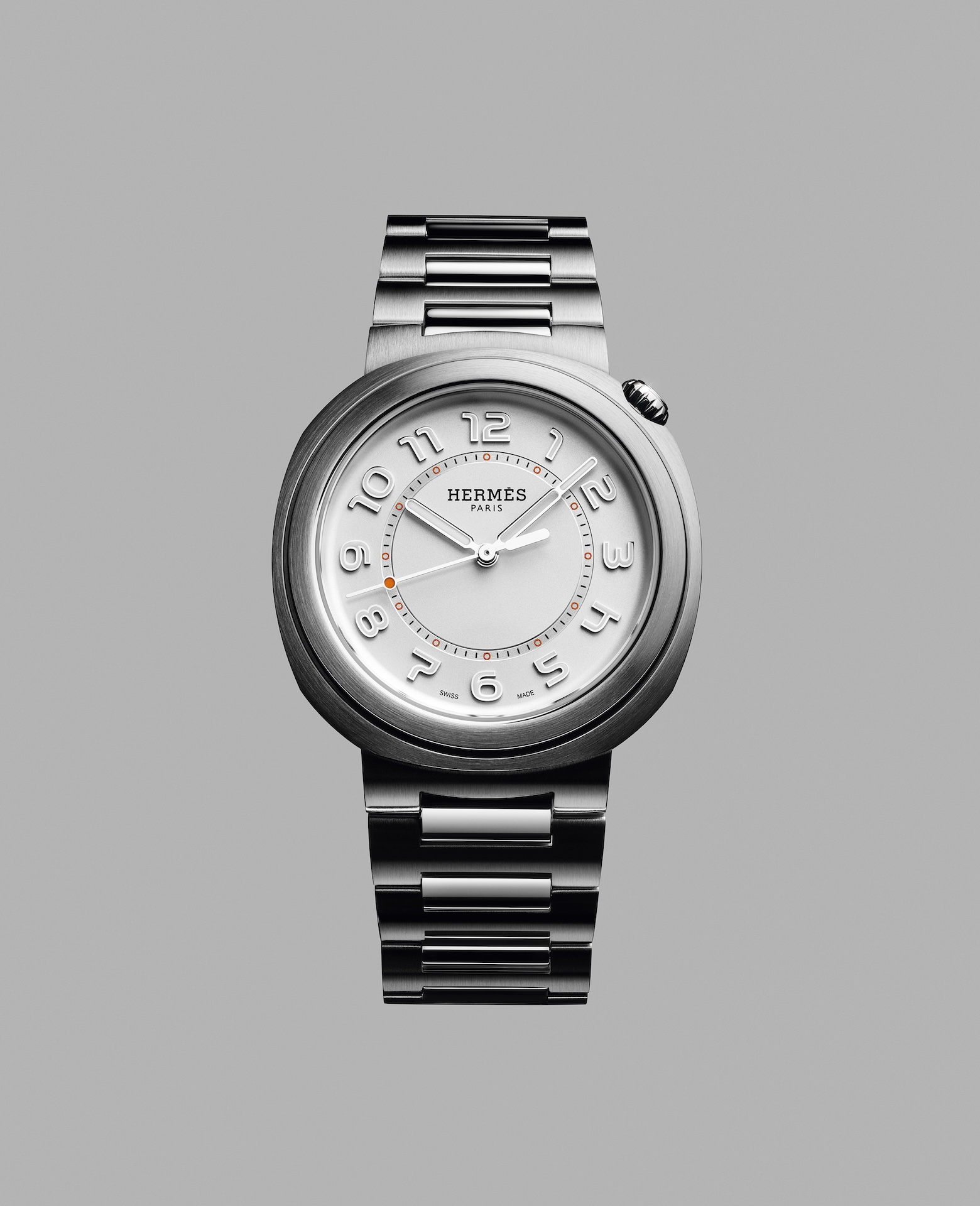
Moving away from the block colours and sporty aesthetic that has defined Hermès watches in recent years, the biggest news from the French luxury goods company at Watches & Wonders came with the unveiling of its newest collection, the Hermès Cut.
It flaunts a round bezel, but the case middle is nearer to a tonneau shape—a relatively simple design that, despite attracting flak from some watch aficionados, works. While marketed as a “women’s watch”, the Cut has universal appeal thanks to its elegant package and proportions. It moves away from the Maison’s penchant for a style-first product; it’s a watch that tells the time, not a fashion accessory with the ability to tell the time.
Hermès gets the proportions just right thanks to a satin-brushed and polished 36 mm case, PVD-treated Arabic numerals, and clean-cut edges that further accentuate its character. One of the key design elements is the positioning of the crown, boldly sitting at half-past one and embellished with a lacquered or engraved “H”, clearly stamping its originality. The watch is powered by a Hermès Manufacture movement H1912, revealed through its sapphire crystal caseback. In addition to its seamlessly integrated and easy-wearing metal bracelet, the Cut also comes with the option for a range of coloured rubber straps. Together with its clever interchangeable system, it’s a cinch to swap out its look.
It will be interesting to see how the Hermès Cut fares in coming months, particularly as it tries to establish its own identity separate from the more aggressive, but widely popular, Ho8 collection. Either way, the company is now a serious part of the dialogue around the concept of time.
—
Read more about this year’s Watches & Wonders exhibition at robbreport.com.au
You may also like.
22/07/2024
Living La Vida Lagerfeld
The world remembers him for fashion. But as a new tome reveals, the iconoclastic designer is defined as much by extravagant, often fantastical, homes as he is clothes.
“Lives, like novels, are made up of chapters”, the world-renowned bibliophile, Karl Lagerfeld, once observed.
Were a psychological-style novel ever to be written about Karl Lagerfeld’s life, it would no doubt give less narrative weight to the story of his reinvigoration of staid fashion houses like Chloe, Fendi and Chanel than to the underpinning leitmotif of the designer’s constant reinvention of himself.
In a lifetime spanning two centuries, Lagerfeld made and dropped an ever-changing parade of close friends, muses, collaborators and ambiguous lovers, as easily as he changed his clothes, his furniture… even his body. Each chapter of this book would be set against the backdrop of one of his series of apartments, houses and villas, whose often wildly divergent but always ultra-luxurious décor reflected the ever-evolving personas of this compulsively public but ultimately enigmatic man.
With the publication of Karl Lagerfeld: A Life in Houses these wildly disparate but always exquisite interiors are presented for the first time together as a chronological body of work. The book indeed serves as a kind of visual novel, documenting the domestic dreamscapes in which the iconic designer played out his many lives, while also making a strong case that Lagerfeld’s impact on contemporary interior design is just as important, if not more so, than his influence on fashion.
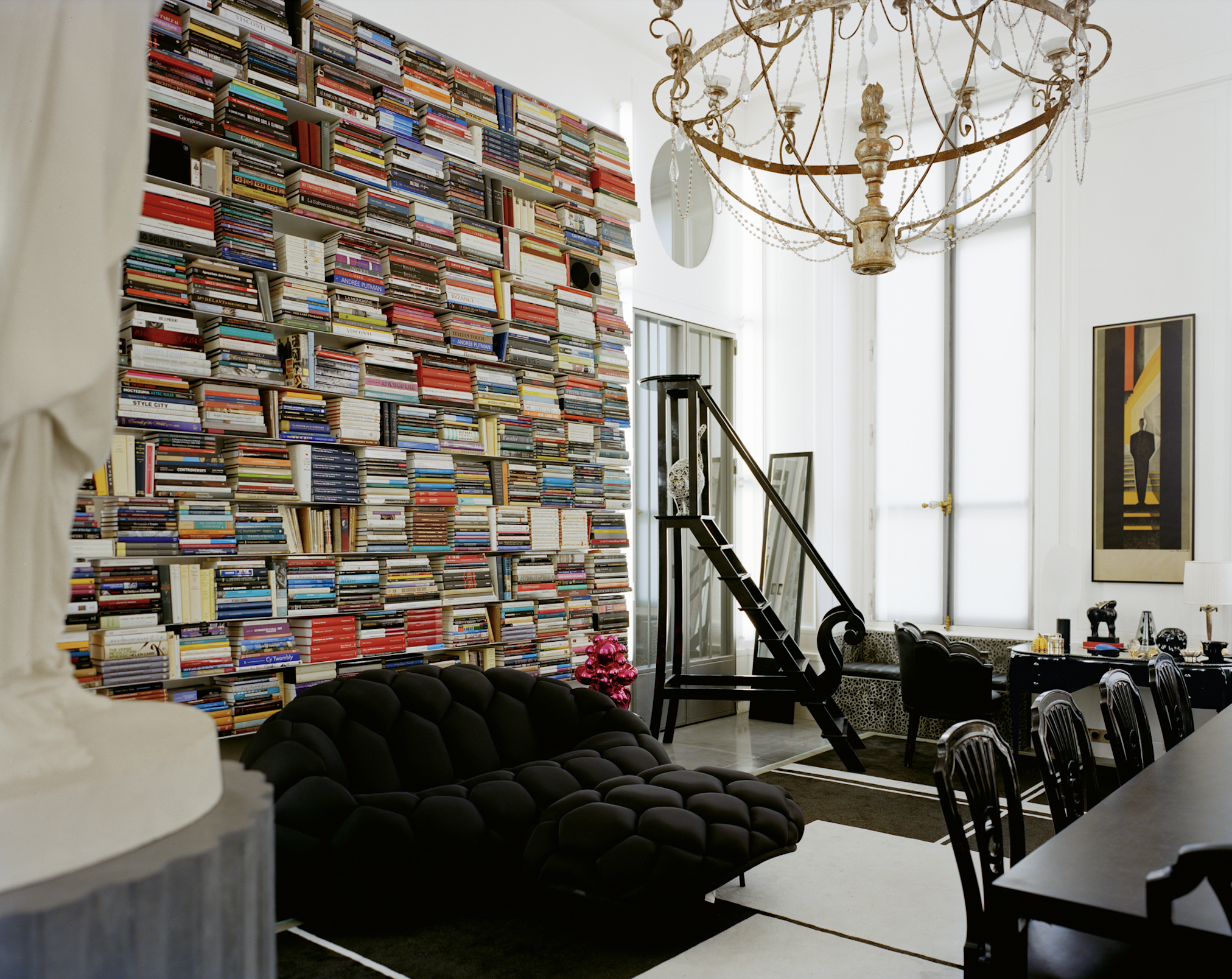
In fact, when the first Lagerfeld interior was featured in a 1968 spread for L’OEil magazine, the editorial describes him merely as a “stylist”. The photographs of the apartment in an 18th-century mansion on rue de Université, show walls lined with plum-coloured rice paper, or lacquered deepest chocolate brown in sharp contrast to crisp, white low ceilings that accentuated the horizontality that was fashionable among the extremely fashionable at the time. Yet amid this setting of aggressively au courant modernism, the anachronistic pops of Art Nouveau and Art Deco objects foreshadow the young Karl’s innate gift for creating strikingly original environments whose harmony is achieved through the deft interplay of contrasting styles and contexts.
Lagerfeld learned early on that presenting himself in a succession of gem-like domestic settings was good for crafting his image. But Lagerfeld’s houses not only provided him with publicity, they also gave him an excuse to indulge in his greatest passion. Shopping!
By 1973, Lagerfeld was living in a new apartment at Place Saint–Sulpice where his acquisition of important Art Deco treasures continued unabated. Now a bearded and muscular disco dandy, he could most often be found in the louche company of the models, starlets and assorted hedonistic beauties that gathered around the flamboyant fashion illustrator Antonio Lopez. Lagerfeld was also in the throes of a hopeless love affair with Jacques de Bascher whose favours he reluctantly shared with his nemesis Yves Saint Laurent.
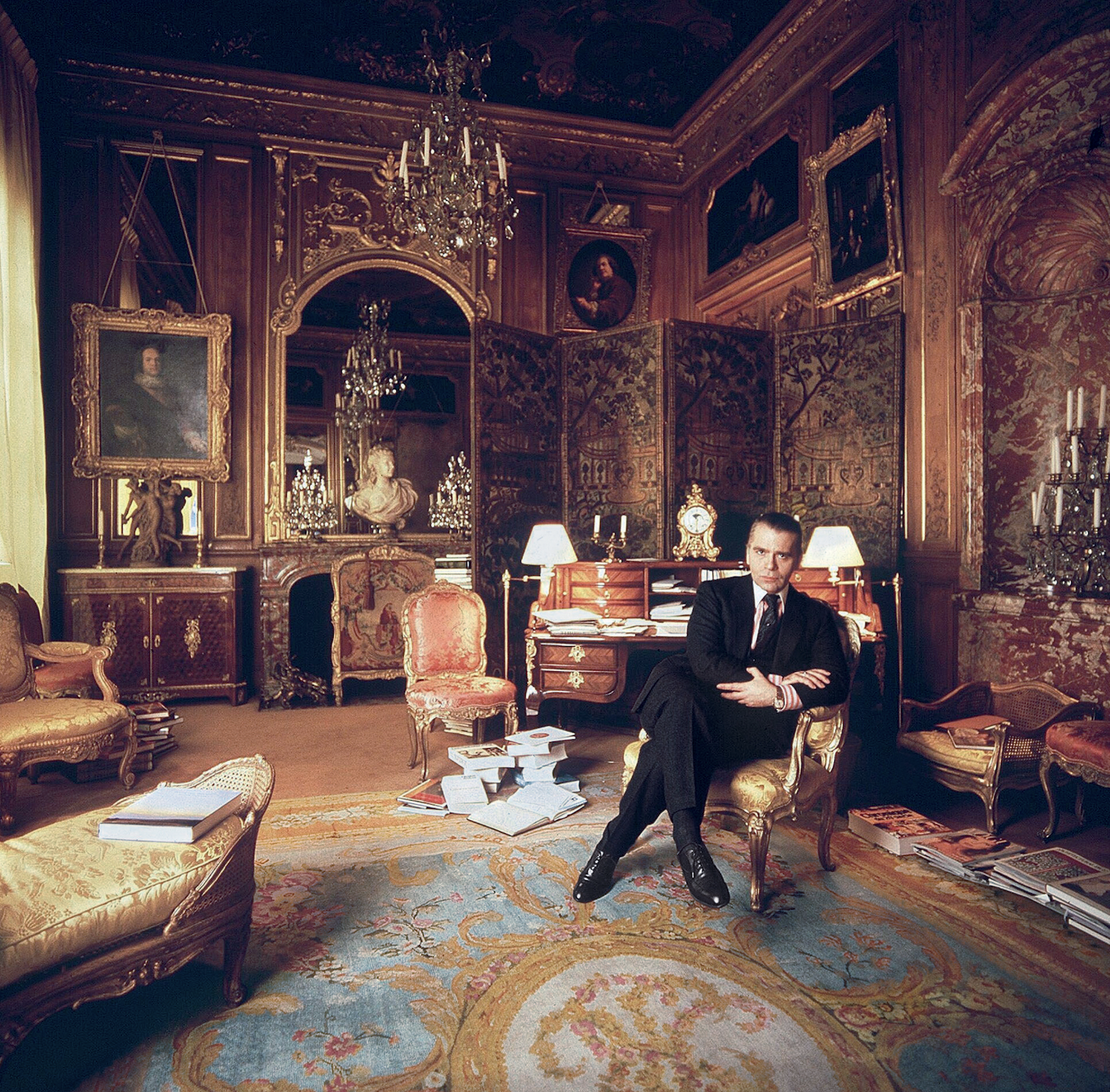
He painted the rooms milky white and lined them with specially commissioned carpets—the tawny patterned striations of which invoked musky wild animal pelts. These lent a stark relief to the sleek, machine-age chrome lines of his Deco furnishings. To contemporary eyes it remains a strikingly original arrangement that subtly conveys the tensions at play in Lagerfeld’s own life: the cocaine fuelled orgies of his lover and friends, hosted in the pristine home of a man who claimed that “a bed is for one person”.
In 1975, a painful falling out with his beloved Jacques, who was descending into the abyss of addiction, saw almost his entire collection of peerless Art Deco furniture, paintings and objects put under the auctioneer’s hammer. This was the first of many auction sales, as he habitually shed the contents of his houses along with whatever incarnation of himself had lived there. Lagerfeld was dispassionate about parting with these precious goods. “It’s collecting that’s fun, not owning,” he said. And the reality for a collector on such a Renaissance scale, is that to continue buying, Lagerfeld had to sell.
Of all his residences, it was the 1977 purchase of Hôtel Pozzo di Borgo, a grand and beautifully preserved 18th-century house, that would finally allow him to fulfill his childhood fantasies of life in the court of Madame de Pompadour. And it was in this aura of Rococó splendour that the fashion designer began to affect, along with his tailored three-piece suits, a courtier’s ponytailed and powdered coif and a coquettish antique fan: marking the beginning of his transformation into a living, breathing global brand that even those with little interest in fashion would immediately recognise.
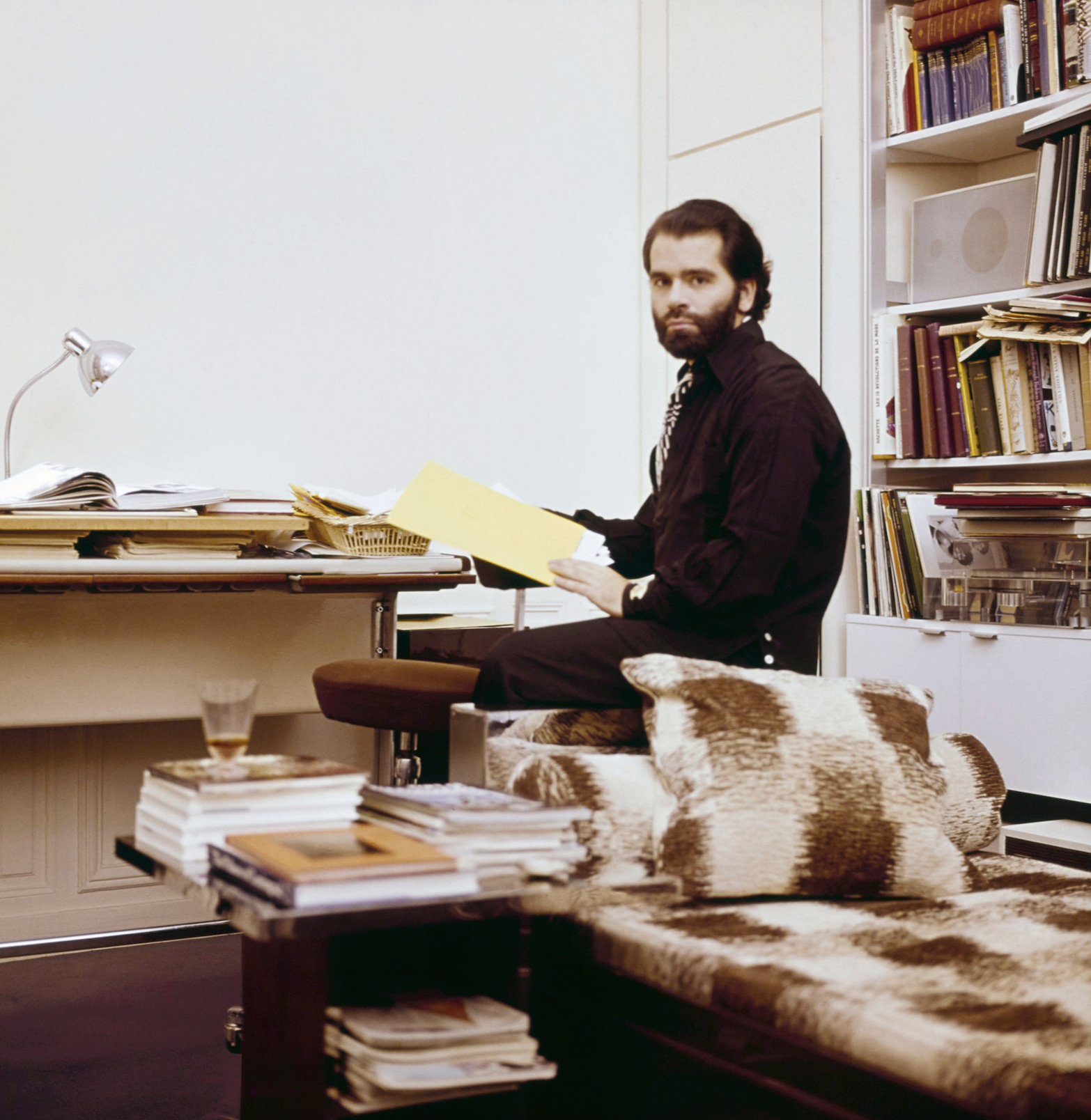
Lagerfeld’s increasing fame and financial success allowed him to indulge in an unprecedented spending frenzy, competing with deep-pocketed institutions like the Louvre to acquire the finest, most pedigreed pearls of the era—voluptuously carved and gilded bergères; ormolu chests; and fleshy, pastel-tinged Fragonard idylls—to adorn his urban palace. His one-time friend André Leon Talley described him in a contemporary article as suffering from “Versailles complex”.
However, in mid-1981, and in response to the election of left-wing president, François Mitterrand, Lagerfeld, with the assistance of his close friend Princess Caroline, became a resident of the tax haven of Monaco. He purchased two apartments on the 21st floor of Le Roccabella, a luxury residential block designed by Gio Ponti. One, in which he kept Jacques de Bascher, with whom he was now reconciled, was decorated in the strict, monochromatic Viennese Secessionist style that had long underpinned his aesthetic vocabulary; the other space, though, was something else entirely, cementing his notoriety as an iconoclastic tastemaker.
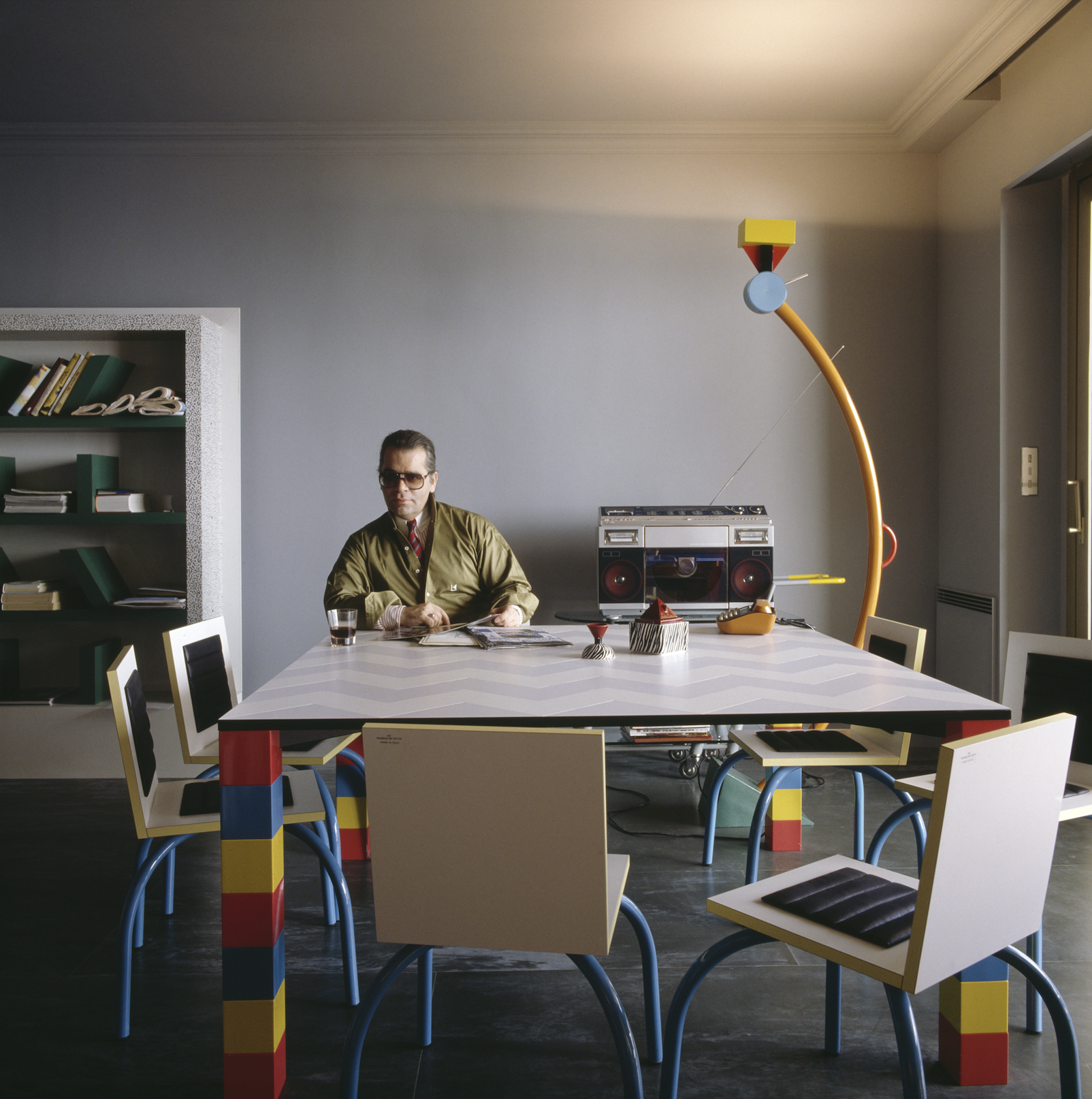
Lagerfeld had recently discovered the radically quirky designs of the Memphis Group led by Ettore Sottsass, and bought the collective’s entire first collection and had it shipped to Monaco. In a space with no right angles, these chaotically colourful, geometrically askew pieces—centred on Masanori Umeda’s famous boxing ring—gave visitors the disorientating sensation of having entered a corporeal comic strip. By 1991, the novelty of this jarring postmodern playhouse had inevitably worn thin and once again he sent it all to auction, later telling a journalist that “after a few years it was like living in an old Courrèges. Ha!”
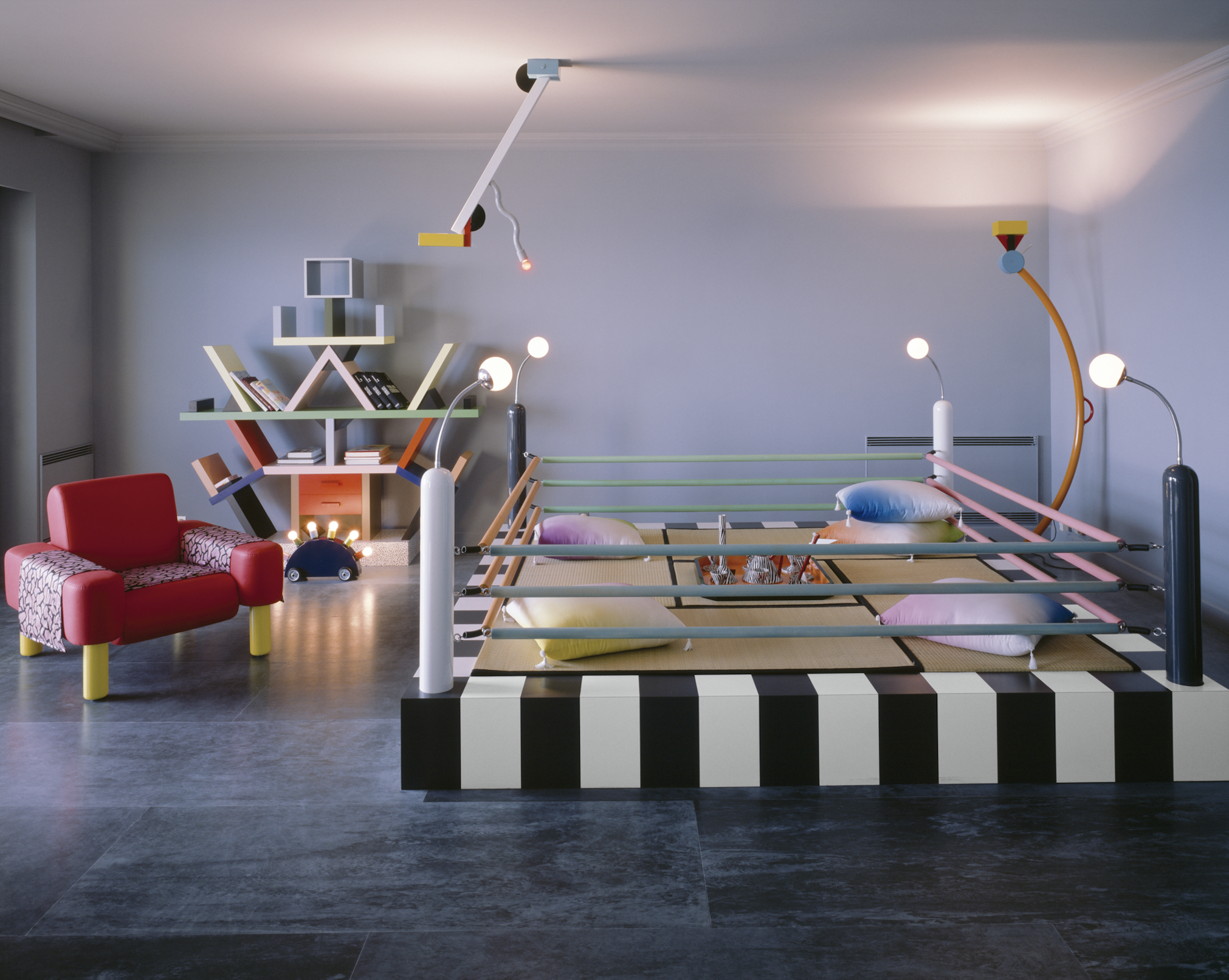
In 1989, de Bascher died of an AIDS-related illness, and while Lagerfeld’s career continued to flourish, emotionally the famously stoic designer was struggling. In 2000, a somewhat corpulent Lagerfeld officially ended his “let them eat cake” years at the Hôtel Pozzo di Borgo, selling its sumptuous antique fittings in a massive headline auction that stretched over three days. As always there were other houses, but now with his longtime companion dead, and his celebrity metastasising making him a target for the paparazzi, he began to look less for exhibition spaces and more for private sanctuaries where he could pursue his endless, often lonely, work.
His next significant house was Villa Jako, named for his lost companion and built in the 1920s in a nouveau riche area of Hamburg close to where he grew up. Lagerfeld shot the advertising campaign for Lagerfeld Jako there—a fragrance created in memorial to de Bascher. The house featured a collection of mainly Scandinavian antiques, marking the aesthetic cusp between Art Nouveau and Art Deco. One of its rooms Lagerfeld decorated based on his remembrances of his childhood nursery. Here, he locked himself away to work—tellingly—on a series of illustrations for the fairy tale, The Emperor’s New Clothes. Villa Jako was a house of deep nostalgia and mourning.
But there were more acts—and more houses—to come in Lagerfeld’s life yet. In November 2000, upon seeing the attenuated tailoring of Hedi Slimane, then head of menswear at Christian Dior, the 135 kg Lagerfeld embarked on a strict dietary regime. Over the next 13 months, he melted into a shadow of his former self. It is this incarnation of Lagerfeld—high white starched collars; Slimane’s skintight suits, and fingerless leather gloves revealing hands bedecked with heavy silver rings—that is immediately recognisable some five years after his death.
The 200-year-old apartment in Quái Voltaire, Paris, was purchased in 2006, and after years of slumber Lagerfeld—a newly awakened Hip Van Winkle—was ready to remake it into his last modernist masterpiece. He designed a unique daylight simulation system that meant the monochromatic space was completely without shadows—and without memory. The walls were frosted and smoked glass, the floors concrete and silicone; and any hint of texture was banned with only shiny, sleek pieces by Marc Newson, Martin Szekely and the Bouroullec Brothers permitted. Few guests were allowed into this monastic environment where Lagerfeld worked, drank endless cans of Diet Coke and communed with Choupette, his beloved Birman cat, and parts of his collection of 300,000 books—one of the largest private collections in the world.
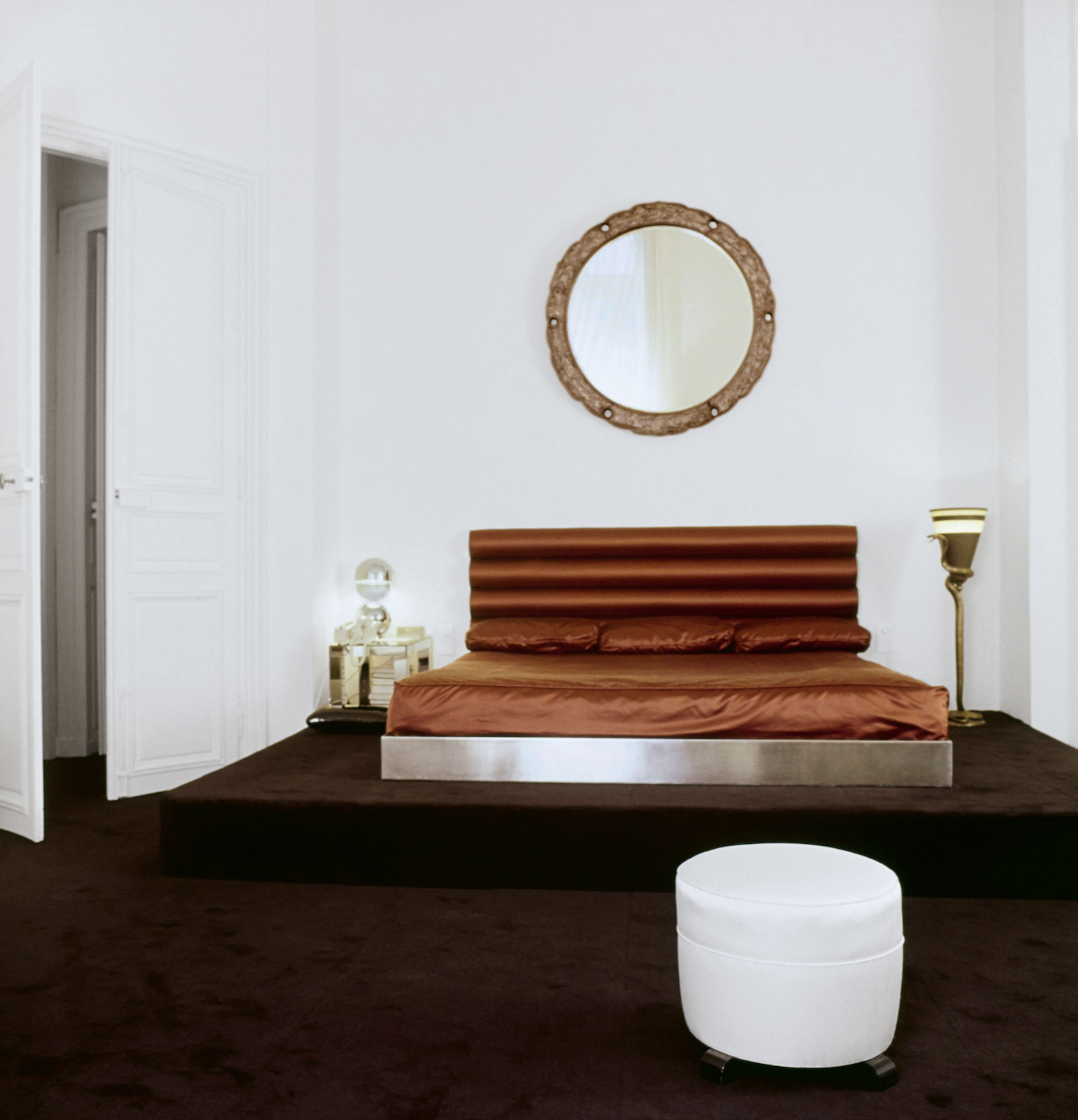
Lagerfeld died in 2019, and the process of dispersing his worldly goods is still ongoing. The Quái Voltaire apartment was sold this year for US$10.8 million (around $16.3 million). Now only the rue de Saint-Peres property remains within the Lagerfeld trust. Purchased after Quái Voltaire to further accommodate more of his books—35,000 were displayed in his studio alone, always stacked horizontally so he could read the titles without straining his neck—and as a place for food preparation as he loathed his primary living space having any trace of cooking smells. Today, the rue de Saint-Peres residence is open to the public as an arts performance space and most fittingly, a library.
You may also like.
By Josh Bozin
24/07/2024
Watch This Space: Mike Nouveau
Meet the game-changing horological influencers blazing a trail across social media—and doing things their own way.
In the thriving world of luxury watches, few people own a space that offers unfiltered digital amplification. And that’s precisely what makes the likes of Brynn Wallner, Teddy Baldassarre, Mike Nouveau and Justin Hast so compelling.
These thought-provoking digital crusaders are now paving the way for the story of watches to be told, and shown, in a new light. Speaking to thousands of followers on the daily—mainly via TikTok, Instagram and YouTube—these progressive commentators represent the new guard of watch pundits. And they’re swaying the opinions, and dollars, of the up-and-coming generations who now represent the target consumer of this booming sector.
—
MIKE NOUVEAU
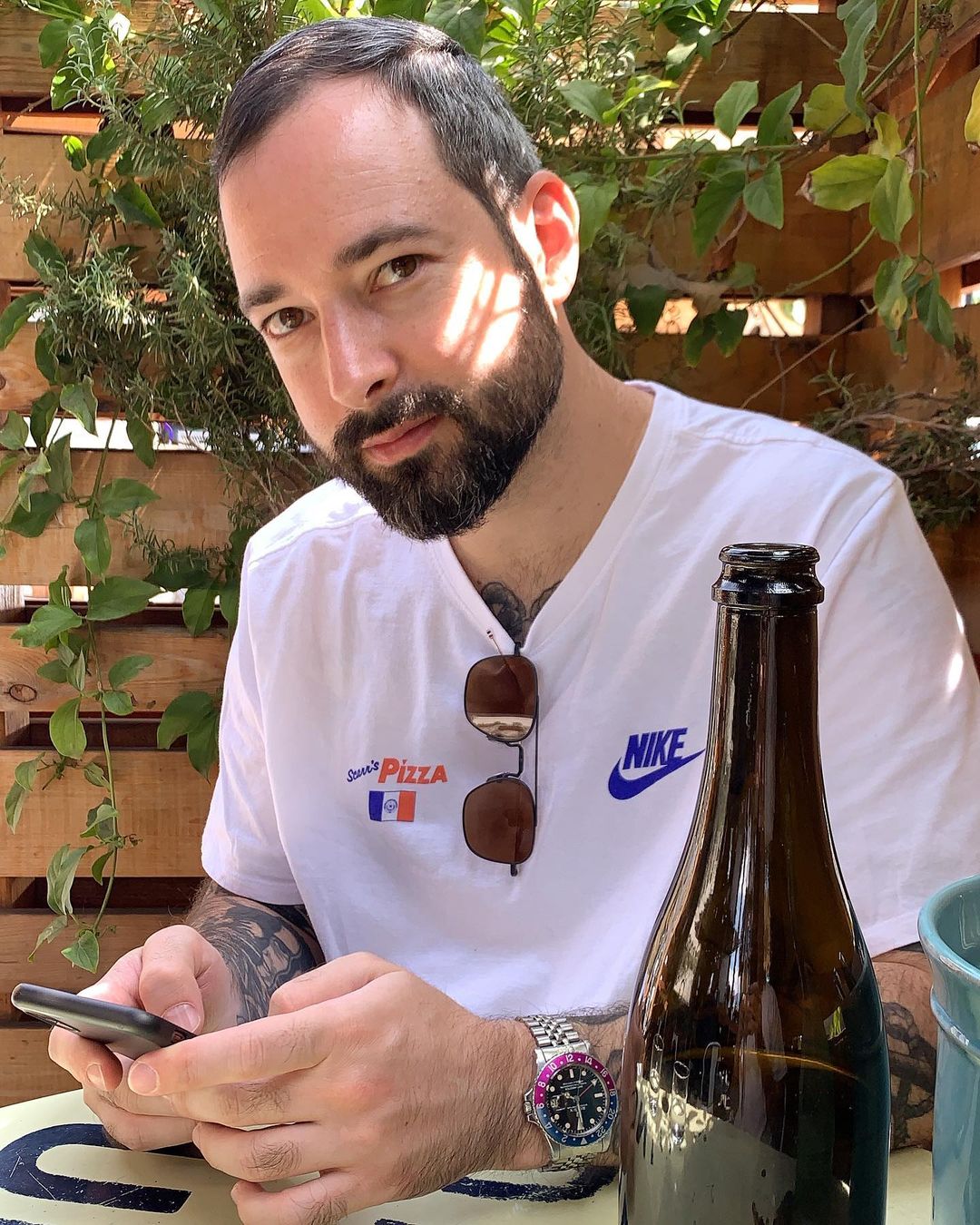
Can we please see what’s on the wrist? That’s the question that catapulted Mike Nouveau into watch stardom, thanks to his penchant for highlighting incredibly rare timepieces across his TikTok account of more than 400,000 followers. When viewing Nouveau’s attention-grabbing video clips—usually shot in a New York City neighbourhood—it’s not uncommon to find him wrist-rolling some of the world’s rarest timepieces, like the million-dollar Cartier Cheich (a clip he posted in May).
But how did someone without any previous watch experience come to amass such a cult following, and in the process gain access to some of the world’s most coveted timepieces? Nouveau admits had been a collector for many years, but moved didn’t move into horology full-time until 2020, when he swapped his DJing career for one as a vintage watch specialist.
“I probably researched for a year before I even bought my first watch,” says Nouveau, alluding to his Rolex GMT Master “Pepsi” ref. 1675 from 1967, a lionised timepiece in the vintage cosmos. “I would see deals arise that I knew were very good, but they weren’t necessarily watches that I wanted to buy myself. I eventually started buying and selling, flipping just for fun because I knew how to spot a good deal.”
Nouveau claims that before launching his TikTok account in the wake of Covid-19, no one in the watch community knew he existed. “There really wasn’t much watch content, if any, on TikTok before I started posting, especially talking about vintage watches. There’s still not that many voices for vintage watches, period,” says Nouveau. “It just so happens that my audience probably skews younger, and I’d say there are just as many young people interested in vintage watches as there are in modern watches.”
View this post on Instagram
Nouveau recently posted a video to his TikTok account revealing that the average price of a watch purchased by Gen Z is now almost US$11,000 (around $16,500), with 41 percent of them coming into possession of a luxury watch in the past 12 months.
“Do as much independent research as you can [when buying],” he advises. “The more you do, the more informed you are and the less likely you are to make a mistake. And don’t bring modern watch expectations to the vintage world because it’s very different. People say, ‘buy the dealer’, but I don’t do that. I trust myself and myself only.”
—
Read more about the influencers shaking up horology here with Justin Hast, Brynn Wallner and Teddy Baldassare.
You may also like.
By Josh Bozin
24/07/2024
This Pristine 1960 Ferrari 250 Spider Could Fetch $24 Million at Auction
The car wears the same colours and has the same engine it left the factory with.
Some Ferraris are just a little bit more important than others.
Take, for example, the 1960 250 GT SWB California that RM Sotheby’s is auctioning off during this year’s Monterey Car Week. Any example of the open-top beauty would attract interest, but this one just so happens to be the first one that was built.
The 250 is one of the most legendary series of cars in Ferrari history. Between 1952 and 1964, the company released 21 different 250 models—seven for racetracks, 14 for public roads—of which the “Cali Spider” might be the most well regarded, thanks to its potent V-12 and a Pininfarina-penned design that is one of the most beautiful bodies to grace an automobile. The roadster, which was specifically built for the U.S., made its debut in 1957 as a long-wheel-base model (LWB), but it wasn’t until the SWB model debut in 1960 that it became clear how special it was. This example isn’t just the first to roll off the line. It’s the actual car that was used to introduce the world to the model at the 1960 Geneva Motor Show.
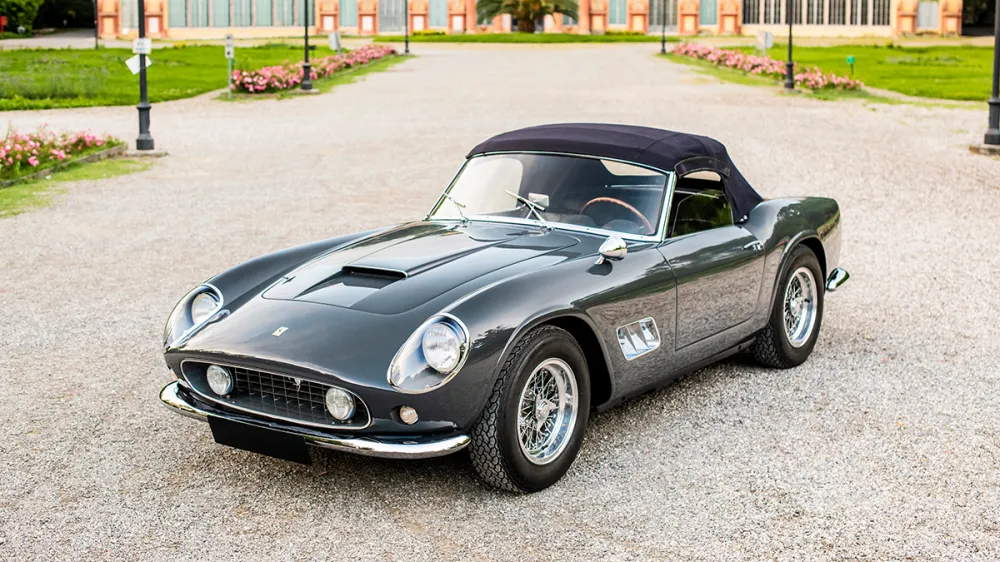
Just 56 examples of the 250 GT SWB California Spider would be built by Scaglietti during the three years it was in production. The first of those, chassis 1795 GT, is finished in a glossy coat of Grigio. The two-door had a red leather interior at Geneva but was returned to the factory and re-outfitted with black leather upholstery before being delivered to its original owner, British race car driver John Gordon Bennet. Six-and-a-half decades later the car looks identical to how it did when it left the factory the second time.
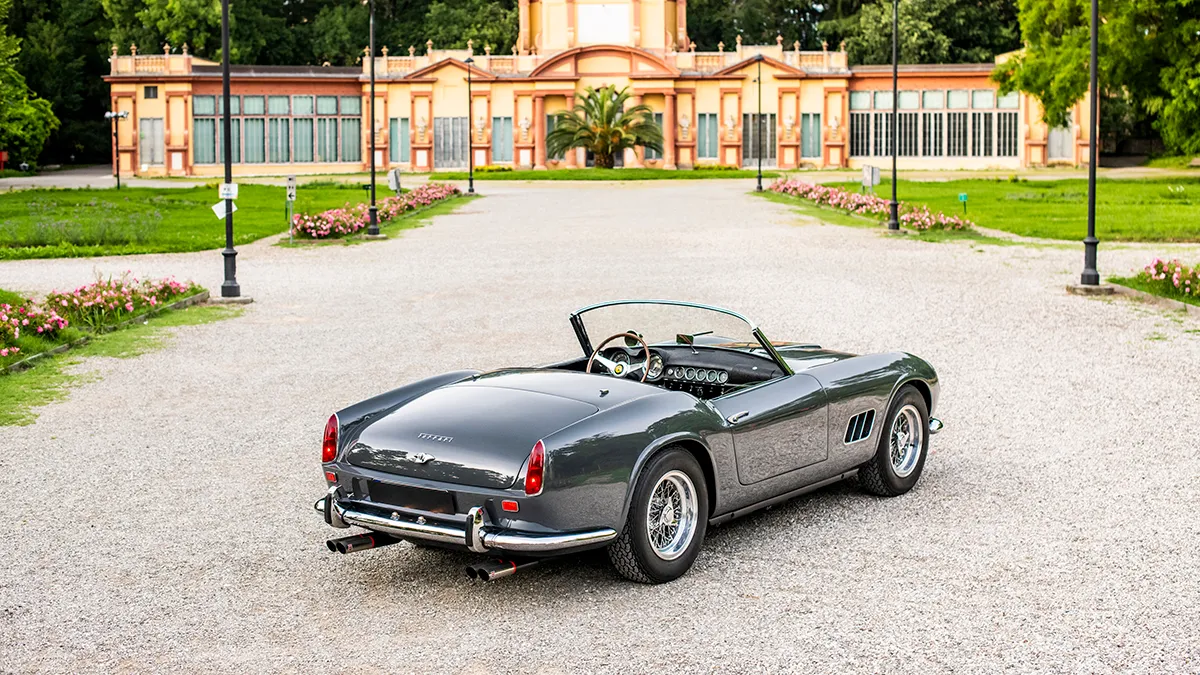
In addition to its original bodywork, the chassis 1795 GT features its original engine, gearbox, and rear axle. That mill is the competition-spec Tipo 168, a 3.0-litre V-12 that makes 196.1 kW. That may not sound like much by today’s standards, but, when you consider that the 250 GT SWB California Spider tips the scales around 952 kilograms, it’s more than enough.
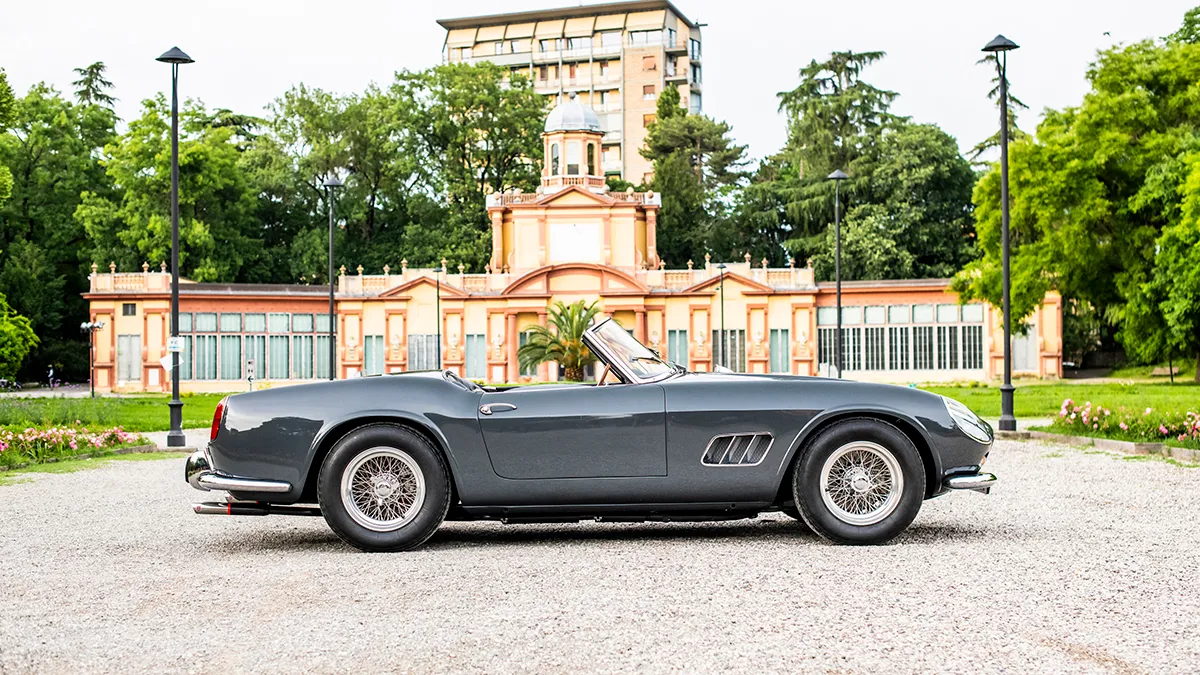
The first 250 GT SWB California Spider is scheduled to go up for bid during RM Sotheby’s annual Monterey Car Week auction, which runs from Thursday, August 15, to Saturday, August 17. Unsurprisingly, the house has quite high hopes for the car. The car carries an estimate of between $24 million and $26 million, which could make it one of the most expensive cars ever sold at auction.
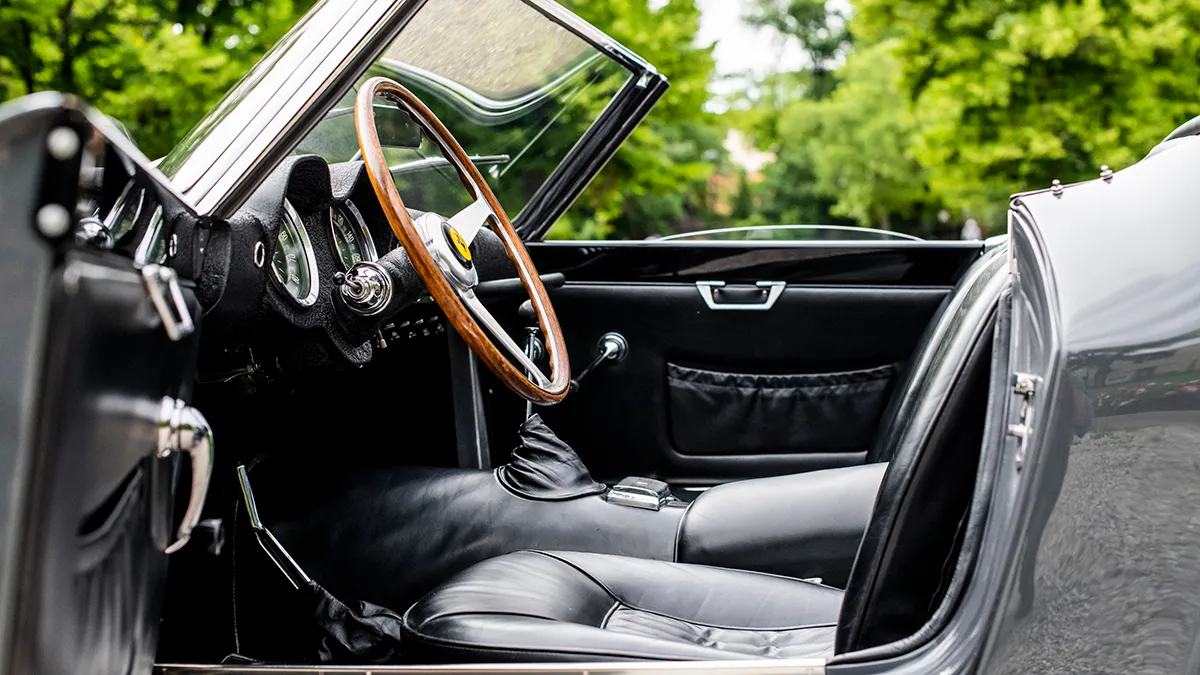
You may also like.
By Josh Bozin
24/07/2024






